Blog > Effective Feedback for Presentations - digital with PowerPoint or with printable sheets

Effective Feedback for Presentations - digital with PowerPoint or with printable sheets
10.26.20 • #powerpoint #feedback #presentation.
Do you know whether you are a good presenter or not? If you do, chances are it's because people have told you so - they've given you feedback. Getting other's opinions about your performance is something that's important for most aspects in life, especially professionally. However, today we're focusing on a specific aspect, which is (as you may have guessed from the title): presentations.

The importance of feedback
Take a minute to think about the first presentation you've given: what was it like? Was it perfect? Probably not. Practise makes perfect, and nobody does everything right in the beginning. Even if you're a natural at speaking and presenting, there is usually something to improve and to work on. And this is where feedback comes in - because how are you going to know what it is that you should improve? You can and should of course assess yourself after each and every presentation you give, as that is an important part of learning and improvement. The problem is that you yourself are not aware of all the things that you do well (or wrong) during your presentation. But your audience is! And that's why you should get audience feedback.
Qualities of good Feedback
Before we get into the different ways of how you can get feedback from your audience, let's briefly discuss what makes good feedback. P.S.: These do not just apply for presentations, but for any kind of feedback.
- Good feedback is constructive, not destructive. The person receiving feedback should feel empowered and inspired to work on their skills, not discouraged. You can of course criticize on an objective level, but mean and insulting comments have to be kept to yourself.
- Good feedback involves saying bot what has to be improved (if there is anything) and what is already good (there is almost always something!)
- After receiving good feedback, the recipient is aware of the steps he can and should take in order to improve.
Ways of receiving / giving Feedback after a Presentation
1. print a feedback form.

Let's start with a classic: the feedback / evaluation sheet. It contains several questions, these can be either open (aka "What did you like about the presentation?") or answered on a scale (e.g. from "strongly disagree" to "strongly agree"). The second question format makes a lot of sense if you have a large audience, and it also makes it easy to get an overview of the results. That's why in our feedback forms (which you can download at the end of this post), you'll find mainly statements with scales. This has been a proven way for getting and giving valuable feedback efficiently for years. We do like the feedback form a lot, though you have to be aware that you'll need to invest some time to prepare, count up and analyse.
- ask specifically what you want to ask
- good overview of the results
- anonymous (people are likely to be more honest)
- easy to access: you can just download a feedback sheet online (ours, for example, which you'll find at the end of this blog post!)
- analysing the results can be time-consuming
- you have to print out the sheets, it takes preparation
2. Online: Get digital Feedback

In the year 2020, there's got to be a better way of giving feedback, right? There is, and you should definitely try it out! SlideLizard is a free PowerPoint extension that allows you to get your audience's feedback in the quickest and easiest way possible. You can of course customize the feedback question form to your specific needs and make sure you get exactly the kind of feedback you need. Click here to download SlideLizard right now, or scroll down to read some more about the tool.
- quick and easy to access
- easy and fast export, analysis and overview of feedback
- save feedback directly on your computer
- Participants need a working Internet connection (but that usually isn't a problem nowadays)
3. Verbal Feedback

"So, how did you like the presentation?", asks the lecturer. A few people in the audience nod friendly, one or two might even say something about how the slides were nice and the content interesting. Getting verbal feedback is hard, especially in big groups. If you really want to analyse and improve your presentation habits and skills, we recommend using one of the other methods. However, if you have no internet connection and forgot to bring your feedback sheets, asking for verbal feedback is still better than nothing.
- no prerequisites
- open format
- okay for small audiences
- not anonymous (people might not be honest)
- time consuming
- no detailed evaluation
- no way to save the feedback (except for your memory)
- not suitable for big audiences
Feedback to yourself - Self Assessment

I've mentioned before that it is incredibly important to not only let others tell you what went well and what didn't in your presentation. Your own impressions are of huge value, too. After each presentation you give, ask yourself the following questions (or better yet, write your answers down!):
- What went wrong (in my opinion)? What can I do in order to avoid this from happening next time?
- What went well? What was well received by the audience? What should I do more of?
- How was I feeling during this presentation? (Nervous? Confident? ...)
Tip: If you really want to actively work on your presentation skills, filming yourself while presenting and analysing the video after is a great way to go. You'll get a different view on the way you talk, move, and come across.

Digital Feedback with SlideLizard
Were you intrigued by the idea of easy Online-feedback? With SlideLizard your attendees can easily give you feedback directly with their Smartphone. After the presentation you can analyze the result in detail.
- type in your own feedback questions
- choose your rating scale: 1-5 points, 1-6 points, 1-5 stars or 1-6 stars;
- show your attendees an open text field and let them enter any text they want

Note: SlideLizard is amazing for giving and receiving feedback, but it's definitely not the only thing it's great for. Once you download the extension, you get access to the most amazing tools - most importantly, live polls and quizzes, live Q&A sessions, attendee note taking, content and slide sharing, and presentation analytics. And the best thing about all this? You can get it for free, and it is really easy to use, as it is directly integrated in PowerPoint! Click here to discover more about SlideLizard.
Free Download: Printable Feedback Sheets for Business or School Presentations
If you'd rather stick with the good old paper-and-pen method, that's okay, too. You can choose between one of our two feedback sheet templates: there is one tailored to business presentations and seminars, and one that is created specifically for teachers assessing their students. Both forms can be downloaded as a Word, Excel, or pdf file. A lot of thought has gone into both of the forms, so you can benefit as much as possible; however, if you feel like you need to change some questions in order to better suit your needs, feel free to do so!
Feedback form for business

Template as PDF, Word & Excel - perfect for seminars, trainings,...
Feedback form for teachers (school or university)

Template as PDF, Word & Excel - perfect for school or university,...
Where can I find a free feedback form for presentations?
There are many templates available online. We designed two exclusive, free-to-download feedback sheets, which you can get in our blog article
What's the best way to get feedback for presentations?
You can get feedback on your presentations by using feedback sheets, asking for feedback verbally, or, the easiest and fastest option: get digital feedback with an online tool
Related articles
About the author.

Pia Lehner-Mittermaier
Pia works in Marketing as a graphic designer and writer at SlideLizard. She uses her vivid imagination and creativity to produce good content.

Get 1 Month for free!
Do you want to make your presentations more interactive.
With SlideLizard you can engage your audience with live polls, questions and feedback . Directly within your PowerPoint Presentation. Learn more

Top blog articles More posts

All about notes in PowerPoint Presentations

Create Flowchart / Decision Tree in PowerPoint – Templates & Tutorial

Get started with Live Polls, Q&A and slides
for your PowerPoint Presentations
The big SlideLizard presentation glossary
Normal view (slide view).
The normal view or slide view is the main working window in your PowerPoint presentation. You can see the slides at their full size on screen.
Declamation Speech
A declamation speech describes the re-giving of an important speech that has been given in the past. It is usually given with a lot of emotion and passion.
Learning Management System (LMS)
Learning Management Systems (LMS) are online platforms that provide learning resources and support the organisation of learning processes.
PowerPoint Online
PowerPoint Online is the web version of PowerPoint. You can present and edit your PowerPoint presentation with it, without having PowerPoint installed on your computer. It's only necessary to have a Microsoft - or a Microsoft 365 account.
Be the first to know!
The latest SlideLizard news, articles, and resources, sent straight to your inbox.
- or follow us on -
We use cookies to personalize content and analyze traffic to our website. You can choose to accept only cookies that are necessary for the website to function or to also allow tracking cookies. For more information, please see our privacy policy .
Cookie Settings
Necessary cookies are required for the proper functioning of the website. These cookies ensure basic functionalities and security features of the website.
Analytical cookies are used to understand how visitors interact with the website. These cookies help provide information about the number of visitors, etc.

How it works
Transform your enterprise with the scalable mindsets, skills, & behavior change that drive performance.
Explore how BetterUp connects to your core business systems.
We pair AI with the latest in human-centered coaching to drive powerful, lasting learning and behavior change.
Build leaders that accelerate team performance and engagement.
Unlock performance potential at scale with AI-powered curated growth journeys.
Build resilience, well-being and agility to drive performance across your entire enterprise.
Transform your business, starting with your sales leaders.
Unlock business impact from the top with executive coaching.
Foster a culture of inclusion and belonging.
Accelerate the performance and potential of your agencies and employees.
See how innovative organizations use BetterUp to build a thriving workforce.
Discover how BetterUp measurably impacts key business outcomes for organizations like yours.
A demo is the first step to transforming your business. Meet with us to develop a plan for attaining your goals.

- What is coaching?
Learn how 1:1 coaching works, who its for, and if it's right for you.
Accelerate your personal and professional growth with the expert guidance of a BetterUp Coach.
Types of Coaching
Navigate career transitions, accelerate your professional growth, and achieve your career goals with expert coaching.
Enhance your communication skills for better personal and professional relationships, with tailored coaching that focuses on your needs.
Find balance, resilience, and well-being in all areas of your life with holistic coaching designed to empower you.
Discover your perfect match : Take our 5-minute assessment and let us pair you with one of our top Coaches tailored just for you.

Research, expert insights, and resources to develop courageous leaders within your organization.
Best practices, research, and tools to fuel individual and business growth.
View on-demand BetterUp events and learn about upcoming live discussions.
The latest insights and ideas for building a high-performing workplace.
- BetterUp Briefing
The online magazine that helps you understand tomorrow's workforce trends, today.
Innovative research featured in peer-reviewed journals, press, and more.
Founded in 2022 to deepen the understanding of the intersection of well-being, purpose, and performance
We're on a mission to help everyone live with clarity, purpose, and passion.
Join us and create impactful change.
Read the buzz about BetterUp.
Meet the leadership that's passionate about empowering your workforce.
For Business
For Individuals
30 presentation feedback examples

Jump to section
You're doing great
You should think of improving
Tips to improve
3 things to look for when providing presentation feedback
3 tips for giving effective feedback.
We’re all learning as we go.
And that’s perfectly OK — that’s part of being human. On my own personal growth journey, I know I need to get better at public speaking and presenting. It’s one of those things that doesn’t necessarily come naturally to me.
And I know there are plenty of people in my shoes. So when it comes to presenting in the workplace, it can be intimidating. But there’s one thing that can help people continue to get better at presentations: feedback .
The following examples not only relate to presentations. They can also be helpful for public speaking and captivating your audience.
You’re doing great
- You really have the natural ability to hand out presentation material in a very organized way! Good job!
- Your presentations are often compelling and visually stunning. You really know how to effectively captivate the audience. Well done!
- You often allow your colleagues to make presentations on your behalf. This is a great learning opportunity for them and they often thrive at the challenge.
- Keeping presentations focused on key agenda items can be tough, but you’re really good at it. You effectively outline exactly what it is that you will be discussing and you make sure you keep to it. Well done!!
- You created downloadable visual presentations and bound them for the client. Excellent way to portray the company! Well done!
- Your content was relevant and your format was visually appealing and easy to follow and understand. Great job! You’re a real designer at heart!
- You always remain consistent with the way you present and often your presentations have the same style and layout. This is great for continuity. Well done!
- You always remain consistent with every presentation, whether it be one on ones, small group chats, with peers, direct reports, and the company bosses. You have no problem presenting in any one of these situations. Well done!
- You are an effective presenter both to employees and to potential clients. When controversial topics come up, you deal with them in a timely manner and you make sure these topics are fully dealt with before moving on. Well done!
- You effectively command attention and you have no problem managing groups during the presentation.

You should think of improving
- You’re a great presenter in certain situations, but you struggle to present in others. Try to be more consistent when presenting so that you get one single-minded message across. This will also help you broaden your presentation skills by being able to portray one single idea or message.
- You tend to be a little shy when making presentations. You have the self-confidence in one-on-one conversations , so you definitely have the ability to make compelling presentations. Come on! You can do it!
- During presentations, there seems to be quite a lack of focus . I know it can be difficult to stick to the subject matter, however you need to in order for people to understand what the presentation is about and what is trying to be achieved.
- To engage with your audience and make them attentively listen to what you have to say, you need to be able to use your voice in an effective manner to achieve this. Try to focus on certain words that require extra attention and emphasis these words during your presentation.
- Knowing your audience is critical to the success of any presentation. Learn to pick up on their body language and social cues to gauge your style and tone. Listen to what your audience has to say and adjust your presentation accordingly.

- During presentations, it’s expected that there will be tough questions . Try to prepare at least a couple of days before the time so that you can handle these questions in an effective manner.
- To be an effective presenter you need to be able to adjust to varying audiences and circumstances. Try learning about who will be in the room at the time of the presentation and adjust accordingly.
- Remember not to take debate as a personal attack. You tend to lose your cool a little too often, which hinders the discussion and people feel alienated. You can disagree without conflict .
- The only way you are going to get better at public speaking is by practicing, practicing, practicing. Learn your speech by heart, practice in the mirror, practice in front of the mirror. Eventually, you’ll become a natural and you won't be afraid of public speaking any longer.
- Your presentations are beautiful and I have no doubt you have strong presentation software skills. However, your content tends to be a bit weak and often you lack the substance. Without important content, the presentation is empty.
Tips to improve
- Remember it’s always good to present about the things you are passionate about . When you speak to people about your passions they can sense it. The same goes for presentations. Identify what it is that excites you and somehow bring it into every presentation. it’ll make it easier to present and your audience will feel the energy you portray.
- Sometimes it can be easier to plan with the end result in mind. Try visualizing what it is you are exactly expecting your audience to come away with and develop your presentation around that.
- Simplicity is a beautiful thing. Try to keep your presentations as simple as possible. Make it visually appealing with the least amount of words possible. Try interactive pictures and videos to fully immerse your audience in the presentation.
- It’s a fine balance between winging the presentation and memorizing the presentation. If you wing it too much it may come across as if you didn't prepare. If you memorize it, the presentation may come off a bit robotic. Try to find the sweet spot, if you can.
- When presenting, try to present in a way that is cause for curiosity . Make people interested in what you have to say to really captivate them. Have a look at some TED talks to get some tips on how you can go about doing this.
- Remember presentations should be about quality, not quantity. Presentations that are text-heavy and go on for longer than they should bore your audience and people are less likely to remember them.
- Try to arrive at every staff meeting on time and always be well prepared. This will ensure that meetings will go smoothly in the future.
- Remember to respect other people's time by always arriving on time or five minutes before the presentation.
- Remember to ask the others in the meeting for their point of view if there are individuals during presentations.
- If you notice presentations are deviating off-topic, try to steer it back to the important topic being discussed.
Presentation feedback can be intimidating. It’s likely the presenter has spent a good deal of time and energy on creating the presentation.
As an audience member, you can hone in on a few aspects of the presentation to help frame your feedback. If it's an oral presentation, you should consider also audience attention and visual aids.
It’s important to keep in mind three key aspects of the presentation when giving feedback.

Communication
- Were the key messages clear?
- Was the speaker clear and concise in their language?
- Did the presenter clearly communicate the key objectives?
- Did the presenter give the audience clear takeaways?
- How well did the presenter’s voice carry in the presentation space?
Delivery
- Was the presentation engaging?
- How well did the presenter capture their audience?
- Did the presenter engage employees in fun or innovative ways?
- How interactive was the presentation?
- How approachable did the presenter appear?
- Was the presentation accessible to all?
Body language and presence
- How did the presenter carry themselves?
- Did the presenter make eye contact with the audience?
- How confident did the presenter appear based on nonverbal communication?
- Were there any nonverbal distractions to the presentation? (i.e. too many hand gestures, facial expressions, etc.)
There are plenty of benefits of feedback . But giving effective feedback isn’t an easy task. Here are some tips for giving effective feedback.
1. Prepare what you’d like to say
I’m willing to bet we’ve all felt like we’ve put our foot in our mouth at one point or another. Knee-jerk, emotional reactions are rarely helpful. In fact, they can do quite the opposite of help.
Make sure you prepare thoughtfully. Think through what feedback would be most impactful and helpful for the recipient. How will you word certain phrases? What’s most important to communicate? What feedback isn’t helpful to the recipient?
You can always do practice runs with your coach. Your coach will serve as a guide and consultant. You can practice how you’ll give feedback and get feedback … on your feedback. Sounds like a big loop, but it can be immensely helpful.
2. Be direct and clear (but lead with empathy)
Have you ever received feedback from someone where you’re not quite sure what they’re trying to say? Me, too.
I’ve been in roundabout conversations where I walk away even more confused than I was before. This is where clear, direct, and concise communication comes into play.
Be clear and direct in your message. But still, lead with empathy and kindness . Feedback doesn’t need to be harsh or cruel. If it’s coming from a place of care, the recipient should feel that care from you.
3. Create dialogue (and listen carefully)
Feedback is never a one-way street. Without the opportunity for dialogue, you’re already shutting down and not listening to the other person. Make sure you’re creating space for dialogue and active listening . Invite questions — or, even better, feedback. You should make the person feel safe, secure, and trusted . You should also make sure the person feels heard and valued.
Your point of view is just that: it's one perspective. Invite team members to share their perspectives, including positive feedback .
You might also offer the recipient the opportunity for self-evaluation . By doing a self-evaluation, you can reflect on things like communication skills and confidence. They might come to some of the same important points you did — all on their own.
Now, let’s go practice that feedback
We're all learners in life.
It's OK to not be perfect . In fact, we shouldn't be. We're perfectly imperfect human beings, constantly learning , evolving, and bettering ourselves.
The same goes for tough things like presentations. You might be working on perfecting your students' presentation. Or you might want to get better at capturing your audience's attention. No matter what, feedback is critical to that learning journey .
Even a good presentation has the opportunity for improvement . Don't forget the role a coach can play in your feedback journey.
Your coach will be able to provide a unique point of view to help you better communicate key points. Your coach can also help with things like performance reviews , presentation evaluations, and even how to communicate with others.
Elevate your communication skills
Unlock the power of clear and persuasive communication. Our coaches can guide you to build strong relationships and succeed in both personal and professional life.
Madeline Miles
Madeline is a writer, communicator, and storyteller who is passionate about using words to help drive positive change. She holds a bachelor's in English Creative Writing and Communication Studies and lives in Denver, Colorado. In her spare time, she's usually somewhere outside (preferably in the mountains) — and enjoys poetry and fiction.
How to not be nervous for a presentation — 13 tips that work (really!)
6 presentation skills and how to improve them, josh bersin on the importance of talent management in the modern workplace, how to give a good presentation that captivates any audience, 8 clever hooks for presentations (with tips), reading the room gives you an edge — no matter who you're talking to, how to make a presentation interactive and exciting, the self presentation theory and how to present your best self, coaching insider: trusting your team as a new manager, similar articles, 30 communication feedback examples, 30 leadership feedback examples for managers, your guide to what storytelling is and how to be a good storyteller, stay connected with betterup, get our newsletter, event invites, plus product insights and research..
3100 E 5th Street, Suite 350 Austin, TX 78702
- Platform Overview
- Integrations
- Powered by AI
- BetterUp Lead
- BetterUp Manage™
- BetterUp Care™
- Sales Performance
- Diversity & Inclusion
- Case Studies
- Why BetterUp?
- About Coaching
- Find your Coach
- Career Coaching
- Communication Coaching
- Life Coaching
- News and Press
- Leadership Team
- Become a BetterUp Coach
- BetterUp Labs
- Center for Purpose & Performance
- Leadership Training
- Business Coaching
- Contact Support
- Contact Sales
- Privacy Policy
- Acceptable Use Policy
- Trust & Security
- Cookie Preferences
- Eviction Notice Forms
- Power of Attorney Forms Forms
- Bill of Sale (Purchase Agreement) Forms
- Lease Agreement Forms
- Rental Application Forms
- Living Will Forms Forms
- Recommendation Letters Forms
- Resignation Letters Forms
- Release of Liability Agreement Forms
- Promissory Note Forms
- LLC Operating Agreement Forms
- Deed of Sale Forms
- Consent Form Forms
- Support Affidavit Forms
- Paternity Affidavit Forms
- Marital Affidavit Forms
- Financial Affidavit Forms
- Residential Affidavit Forms
- Affidavit of Identity Forms
- Affidavit of Title Forms
- Employment Affidavit Forms
- Affidavit of Loss Forms
- Gift Affidavit Forms
- Small Estate Affidavit Forms
- Service Affidavit Forms
- Heirship Affidavit Forms
- Survivorship Affidavit Forms
- Desistance Affidavit Forms
- Discrepancy Affidavit Forms
- Guardianship Affidavit Forms
- Undertaking Affidavit Forms
- General Affidavit Forms
- Affidavit of Death Forms
- Evaluation Forms
Presentation Evaluation Form
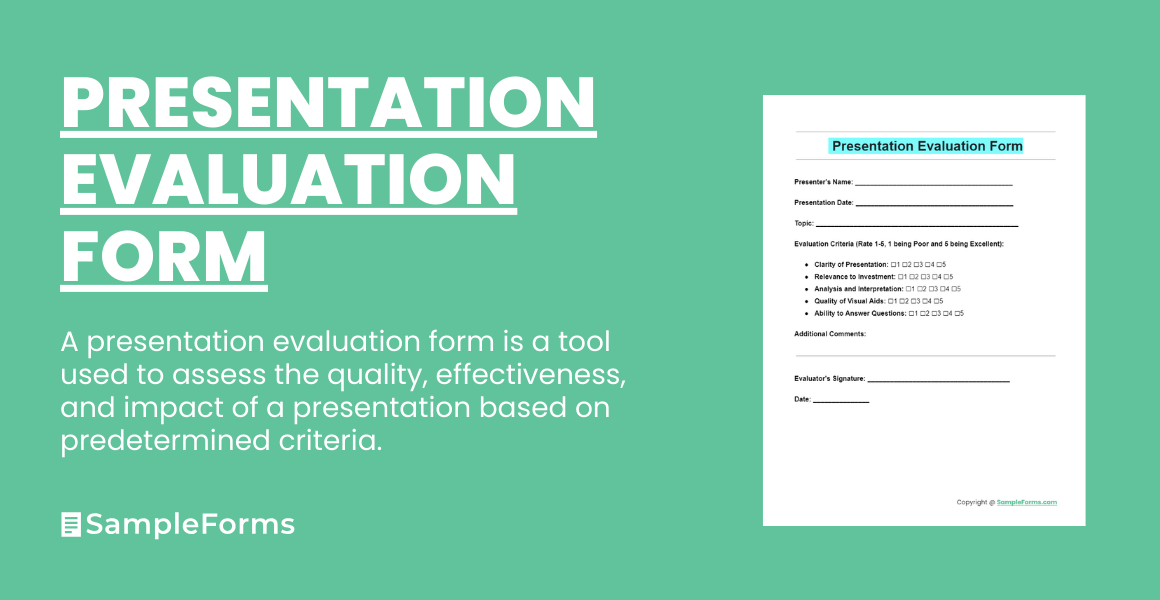
Sample Oral Presentation Evaluation Forms - 7+ Free Documents in ...
Presentation evaluation form sample - 8+ free documents in word ..., 7+ oral presentation evaluation form samples - free sample ....
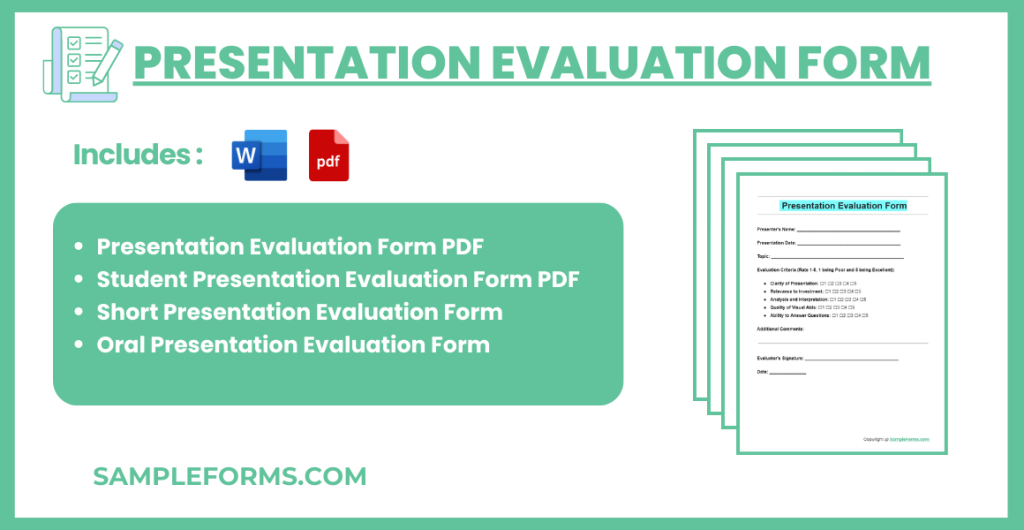
Download Presentation Evaluation Form Bundle
What is Presentation Evaluation Form?
A Presentation Evaluation Form is a structured tool designed for assessing and providing feedback on presentations. It systematically captures the effectiveness, content clarity, speaker’s delivery, and overall impact of a presentation. This form serves as a critical resource in educational settings, workplaces, and conferences, enabling presenters to refine their skills based on constructive feedback. Simple to understand yet comprehensive, this form bridges the gap between presenter effort and audience perception, facilitating a pathway for growth and improvement.
Presentation Evaluation Format
Title: investment presentation evaluation, section 1: presenter information, section 2: evaluation criteria.
- Clarity and Coherence:
- Depth of Content:
- Delivery and Communication:
- Engagement and Interaction:
- Use of Supporting Materials (Data, Charts, Visuals):
Section 3: Overall Rating
- Satisfactory
- Needs Improvement
Section 4: Comments for Improvement
- Open-ended section for specific feedback and suggestions.
Section 5: Evaluator Details
Presentation evaluation form pdf, word, google docs.
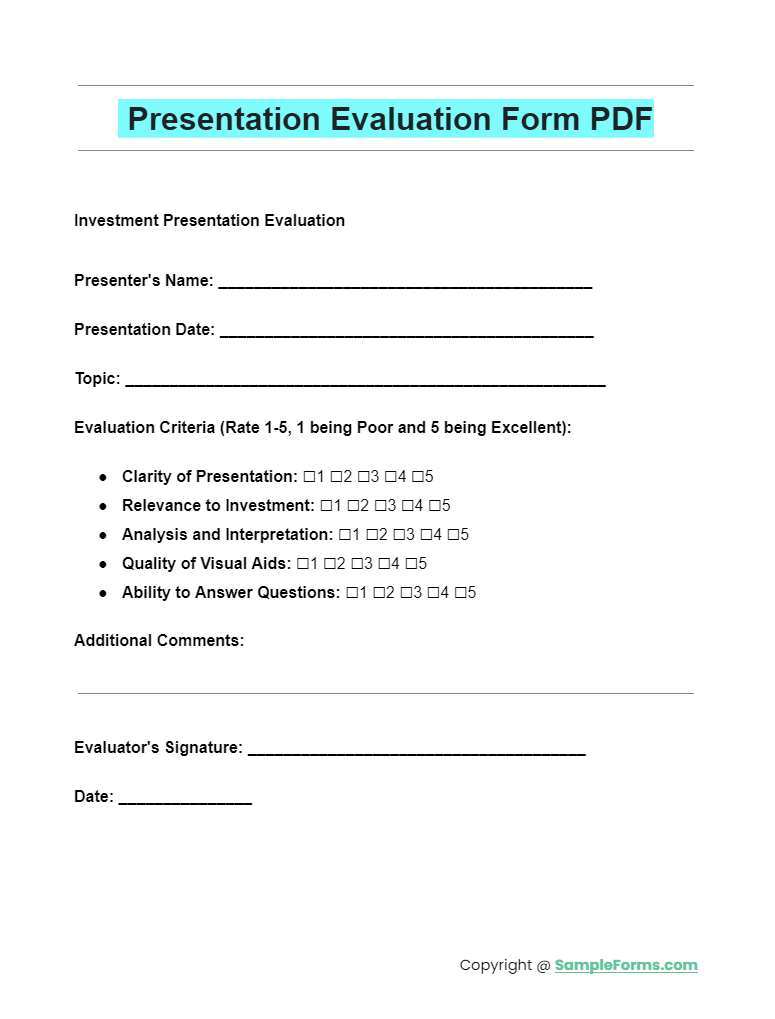
PDF Word Google Docs
Explore the essential tool for assessing presentations with our Presentation Evaluation Form PDF. Designed for clarity and effectiveness, this form aids in pinpointing areas of strength and improvement. It seamlessly integrates with the Employee Evaluation Form , ensuring comprehensive feedback and developmental insights for professionals aiming to enhance their presentation skills. You should also take a look at our Peer Evaluation Form
Student Presentation Evaluation Form PDF

Tailored specifically for educational settings, the Student Presentation Evaluation Form PDF facilitates constructive feedback for student presentations. It encourages growth and learning by focusing on content delivery and engagement. This form is a vital part of the Self Evaluation Form process, helping students reflect on their performance and identify self-improvement areas. You should also take a look at our Call Monitoring Evaluation Form
Short Presentation Evaluation Form
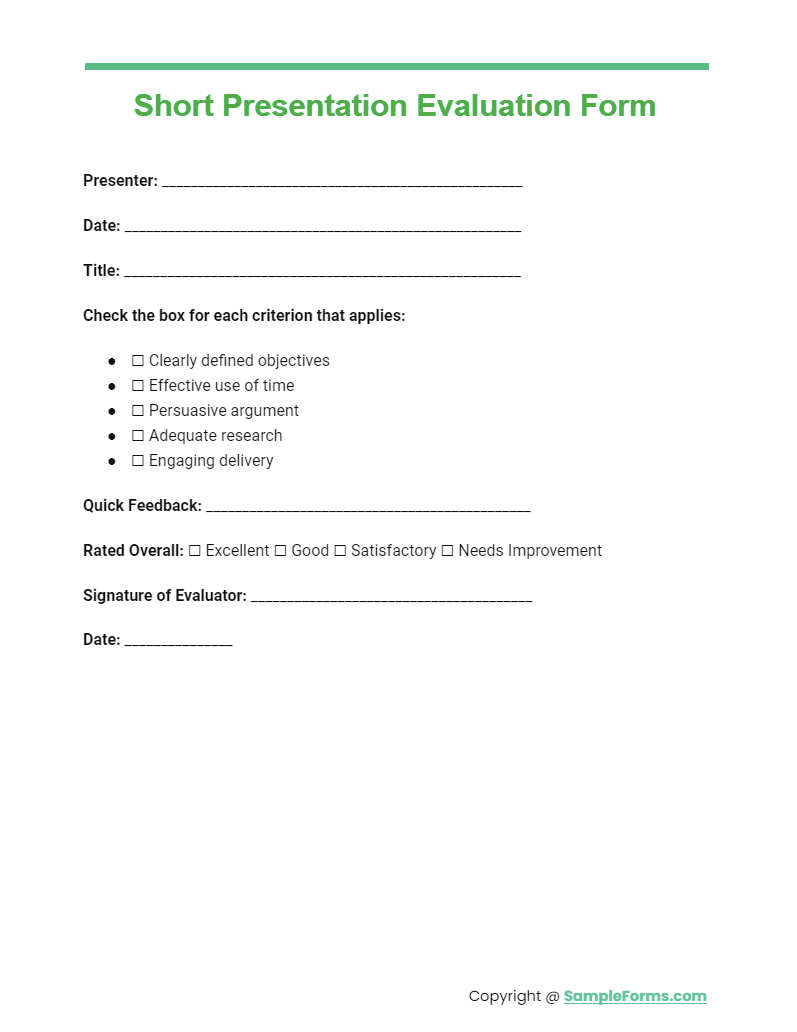
Our Short Presentation Evaluation Form is the perfect tool for quick and concise feedback. This streamlined version captures the essence of effective evaluation without overwhelming respondents, making it ideal for busy environments. Incorporate it into your Training Evaluation Form strategy to boost learning outcomes and presentation efficacy. You should also take a look at our Employee Performance Evaluation Form
Oral Presentation Evaluation Form
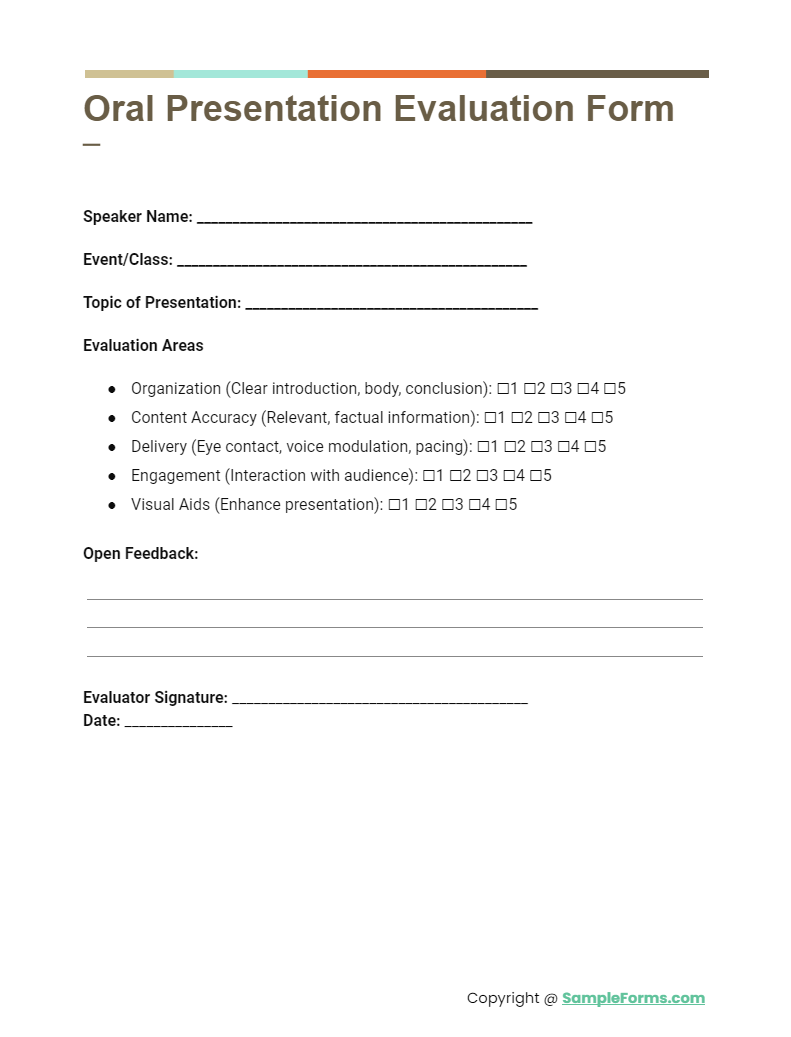
The Oral Presentation Evaluation Form focuses on the delivery and content of spoken presentations. It’s designed to provide speakers with clear, actionable feedback on their verbal communication skills, engaging the audience, and conveying their message effectively. This form complements the Employee Self Evaluation Form , promoting self-awareness and improvement in public speaking skills. You should also take a look at our Interview Evaluation Form
More Presentation Evaluation Form Samples Business Plan Presentation Evaluation Form

nebusinessplancompetition.com
This form is used to evaluate the oral presentation. The audience has to explain whether the materials presented were clear, logical or sequential. The form is also used to explain whether the time frame of the presentation was appropriate. They have to evaluate whether the presentation conveyed professionalism and demonstrated knowledge of the industry.
Group Presentation Evaluation Form
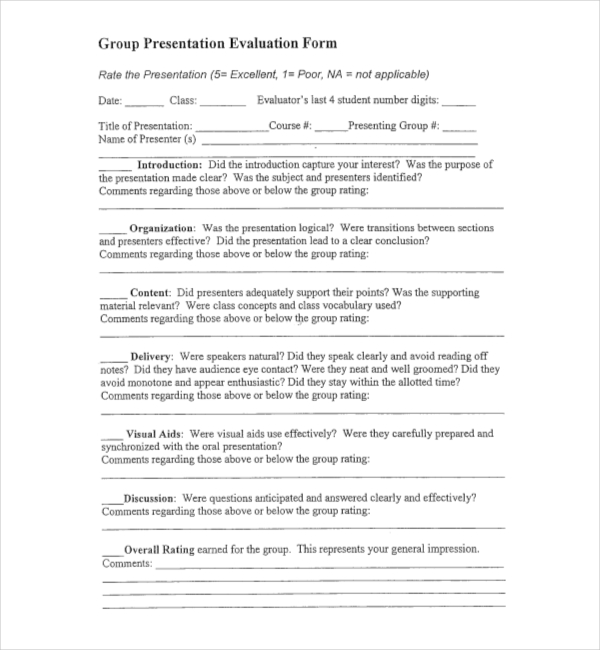
homepages.stmartin.edu
This form is used to explain whether the introduction was capturing their interest. They have to further explain whether the purpose of the presentation clear and logical. They have to explain whether the presentation resulted in a clear conclusion. They have to explain whether the speakers were natural and clear and whether they made eye contact.
Formal Presentation Evaluation Form
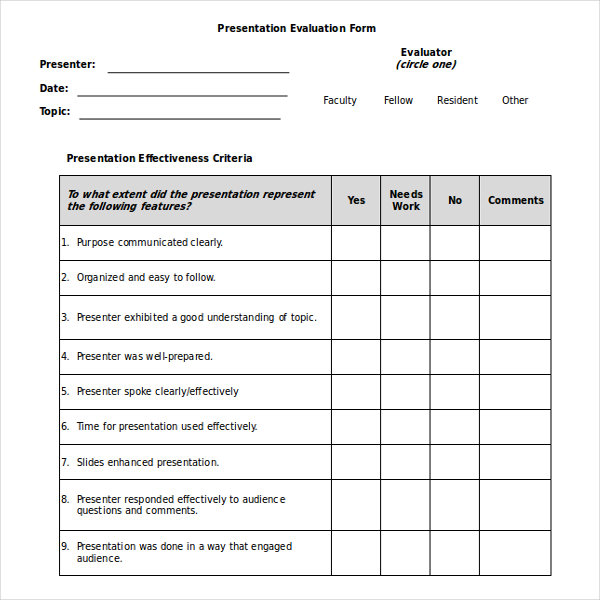
This form is used by audience of the presentation to explain whether the purpose was communicated clearly. They have to further explain whether it was well organized and the presenter had understanding of the topic. The form is used to explain whether the presenter was well-prepared and spoke clearly.
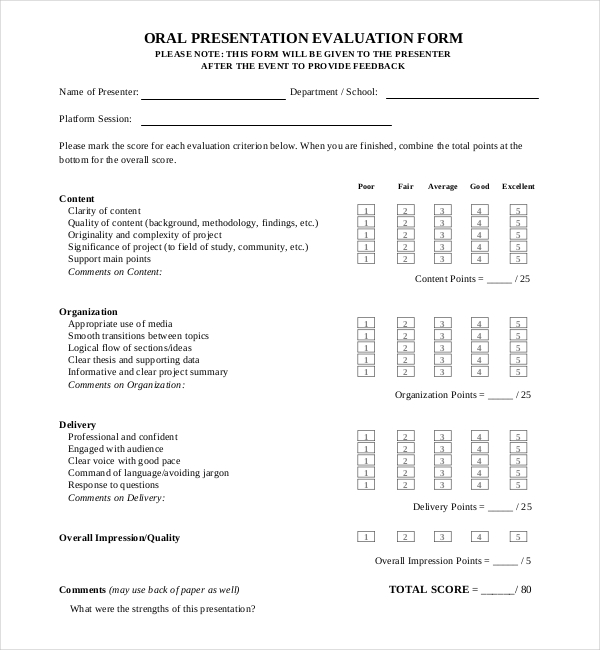
This form is used to evaluate the presentation and circling the suitable rating level. One can also use the provided space to include comments that support ratings. The aim of evaluating the presentation is to know strengths and find areas of required improvement.
Sample Group Presentation Evaluation Form
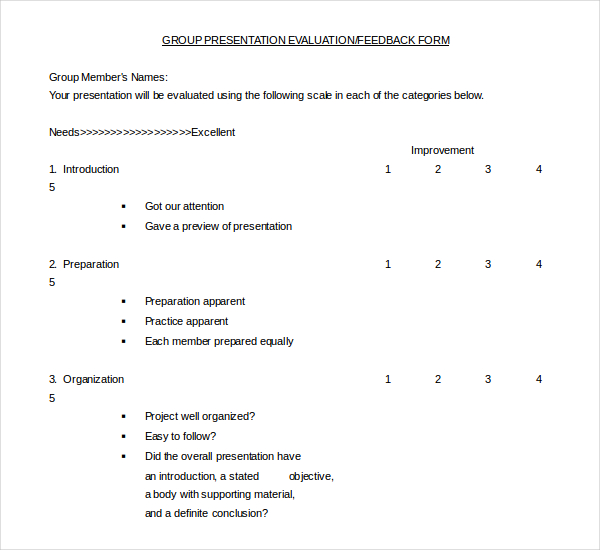
scc.spokane.edu
This form is used by students for evaluating other student’s presentation that follow a technical format. It is criteria based form which has points assigned for several criteria. This form is used by students to grade the contributions of all other members of their group who participated in a project.
Presentation Evaluation Form Sample Download

english.wisc.edu
It is vital to evaluate a presentation prior to presenting it to the audience out there. Therefore, the best thing to do after one is done making the presentation is to contact review team in the organization. He/she should have the presentation reviewed prior to the actual presentation day.
Presentation Skills Evaluation Form
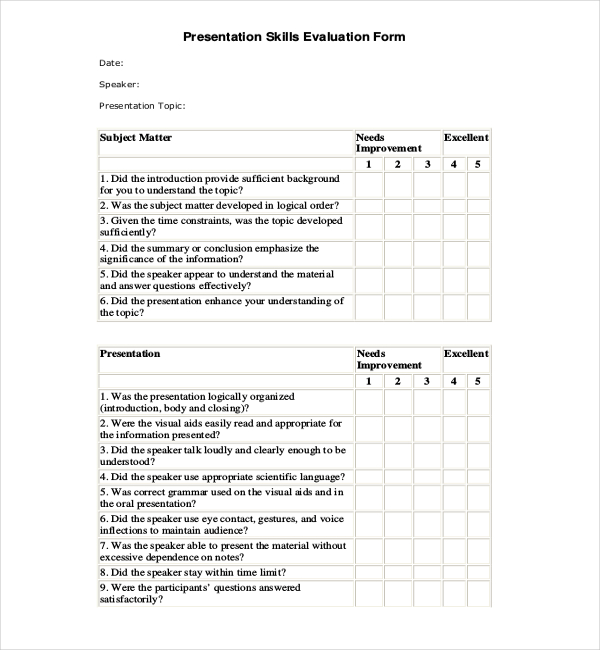
samba.fsv.cuni.cz
There is sample of presentation skills Evaluation forms that one can use to conduct the evaluation. They can finally end up with the proper data as necessary. As opposed to creating a form from scratch, one can simply browse through the templates accessible. They have to explain whether the time and slides effectively used.
Presentation Evaluation Form Community Health Workers Course

This form is used to explain the best parts and worst parts of the presentation. The user has to explain whether the presenter described the healthy housing and action steps. They have to explain whether the presenter has missed any points and the ways presenter can improve.
Mini Presentation Evaluation Form

This form is used to explain whether the presenter created a setting for positive learning experience and the way they did. They have to further explain the way the presenter encouraged participation. They have to rate the trainer’s presentation style, knowledge, eye contact, voice and hand gestures.
Seminar Presentation Evaluation Form
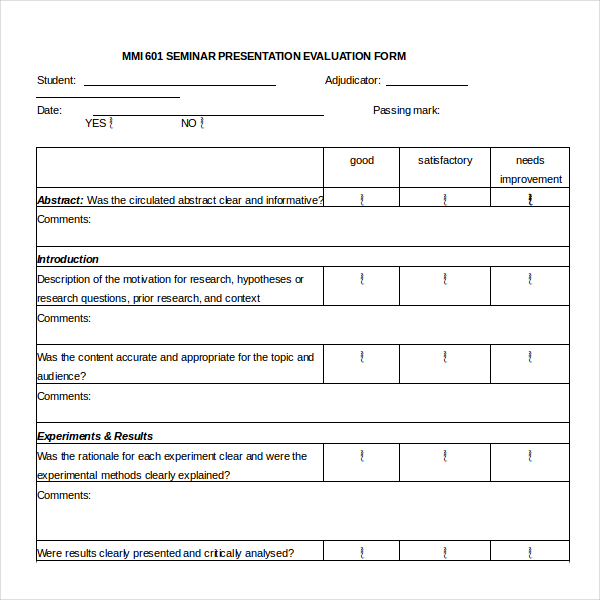
mmi.med.ualberta.ca
This form is used to give constructive feedback to the students who are presenting any of their seminars. The evaluation results will be used to enhance the effectiveness of the speaker. The speaker will discuss the evaluations with the graduate student’s adviser. This form can be used to add comments.
Evaluation Form for Teaching and Presentations
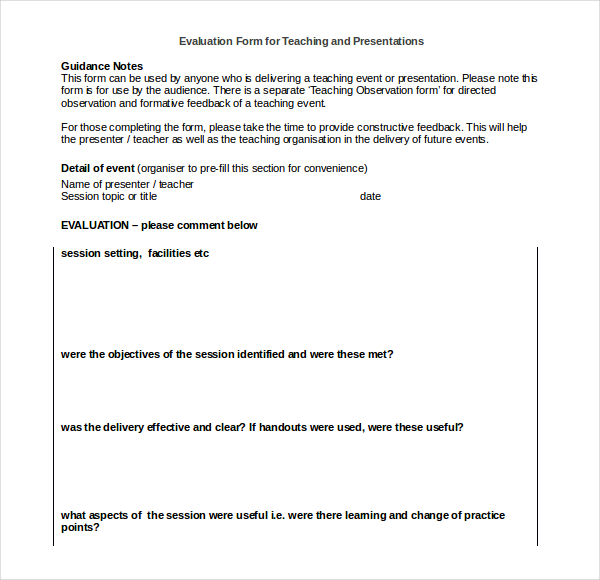
jrcptb.org.uk
This form is used by anyone who is providing a teaching presentation. This form is for use of the audience. There is a different Teaching Observation assessment for formative feedback and direct observation of a teaching event. They are asked to provide constructive feedback to help the presenter and the teaching organization in future events.
Poster Presentation Evaluation Form
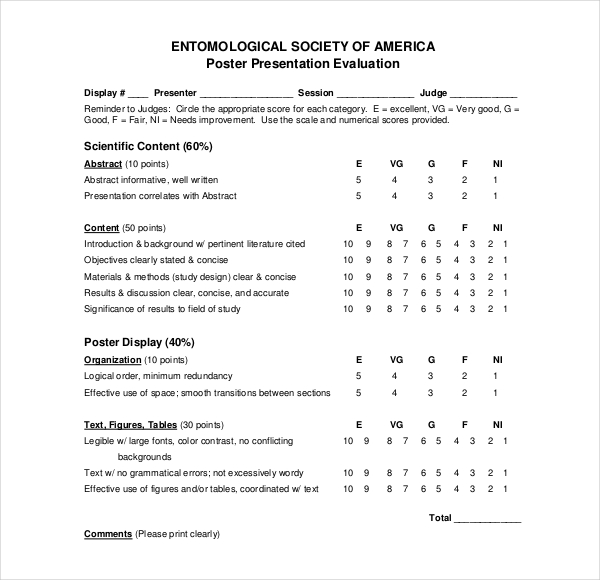
This form involves inspection of the poster with the evaluation of the content and visual presentation. It is also used to discuss the plan to present poster to a reviewer. The questions asked in this process, needs to be anticipated by them. They also add comments, if necessary.
Technical Presentation Evaluation Form
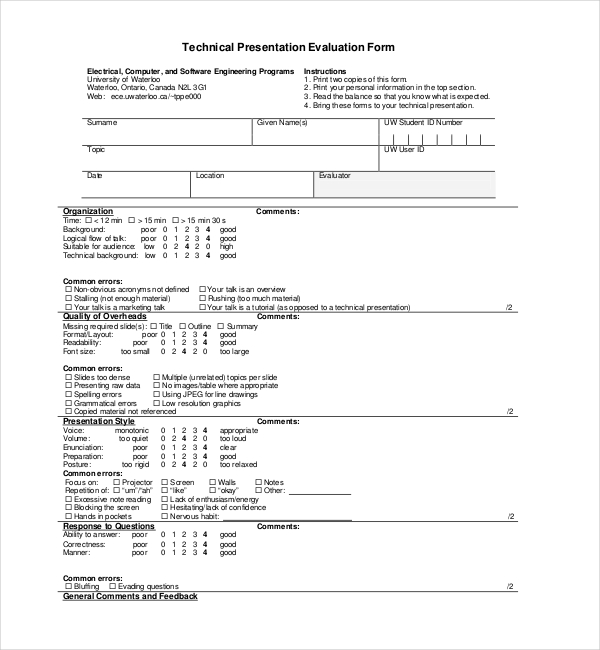
uwaterloo.ca
This form is used to explain whether the introduction, preparation, content, objectives and presentation style was appropriate. It is also used to explain whether it was visually appealing, the project was well presented and the conclusion ended with a summary. One is also asked to explain whether the team was well connected with each other. One can also add overall rating of the project and add comments and grade.
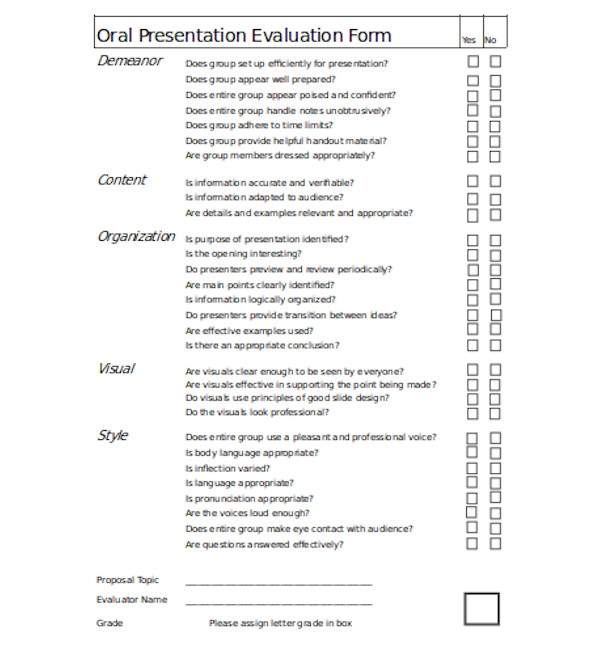
msatterw.public.iastate.edu

10 Uses of Presentation Evaluation Form
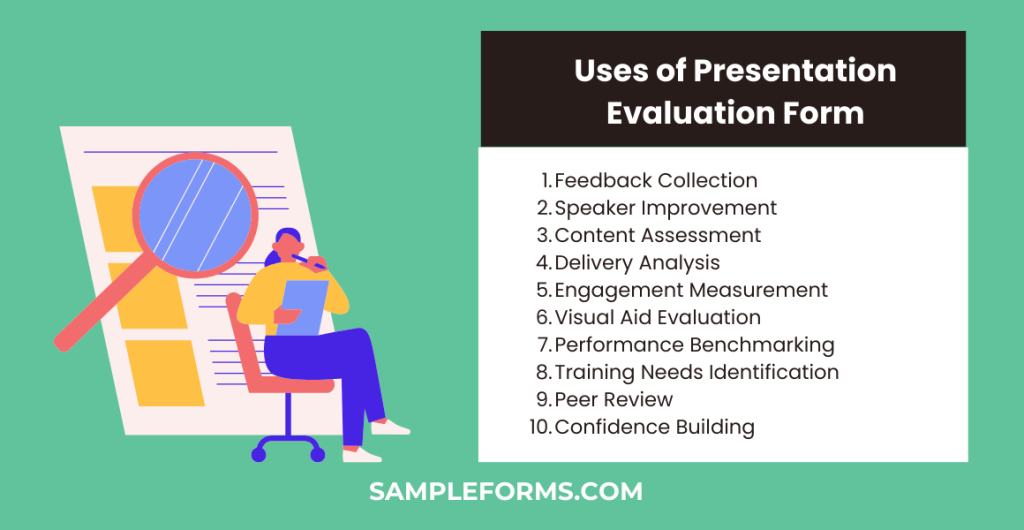
- Feedback Collection: Gathers constructive feedback from the audience or evaluators.
- Speaker Improvement: Identifies strengths and areas for improvement for the presenter.
- Content Assessment: Evaluates the relevance and quality of presentation content.
- Delivery Analysis: Reviews the effectiveness of the presenter’s delivery style.
- Engagement Measurement: Gauges audience engagement and interaction.
- Visual Aid Evaluation: Assesses the impact and appropriateness of visual aids used.
- Performance Benchmarking: Sets benchmarks for future presentations.
- Training Needs Identification: Identifies training and development needs for presenters.
- Peer Review: Facilitates peer feedback and collaborative improvement.
- Confidence Building: Helps presenters gain confidence through structured feedback.
How do you write a Presentation Evaluation?
Writing a presentation evaluation begins with understanding the objectives of the presentation. Incorporate elements from the Seminar Evaluation Form to assess the relevance and delivery of content. The evaluation should include:
- An Introduction that outlines the context and purpose of the presentation, setting the stage for the feedback.
- Criteria Assessment , where each aspect of the presentation, such as content clarity, audience engagement, and visual aid effectiveness, is evaluated. For instance, using a Resume Evaluation Form might inspire the assessment of organizational skills and preparedness.
- Overall Impression and Conclusion , which summarize the presentation’s strengths and areas for improvement, providing actionable suggestions for development. This mirrors the approach in a Proposal Evaluation Form , focusing on the impact and feasibility of the content presented.
How do you Evaluate Presentation Performance?
To evaluate presentation performance effectively, consider both the content and the presenter’s delivery skills. Similar to the structured feedback provided in a Speaker Evaluation Form , the evaluation should encompass:
- Content Quality , assessing the accuracy, relevance, and organization of the information presented.
- Delivery Skills , including the presenter’s ability to communicate clearly, maintain eye contact, and engage with the audience.
- The use of Visual Aids and their contribution to the presentation’s overall impact.
- Audience Response , gauging the level of engagement and feedback received, which can be compared to insights gained from an Activity Evaluation Form .
What are 3 examples of Evaluation Forms?
Various evaluation forms can be employed to cater to different assessment needs:
- A Chef Evaluation Form is essential for culinary presentations, focusing on creativity, presentation, and technique.
- The Trainee Evaluation Form offers a comprehensive review of a trainee’s performance, including their learning progress and application of skills.
- For technology-based presentations, a Website Evaluation Form can assess the design, functionality, and user experience of digital projects.
What are the Evaluation Methods for Presentation?
Combining qualitative and quantitative methods enriches the evaluation process. Direct observation allows for real-time analysis of the presentation, while feedback surveys, akin to those outlined in a Performance Evaluation Form , gather audience impressions. Self-assessment encourages presenters to reflect on their performance, utilizing insights similar to those from a Vendor Evaluation Form . Lastly, peer reviews provide an unbiased feedback loop, essential for comprehensive evaluations. Incorporating specific forms and methods, from the Program Evaluation Form to the Basketball Evaluation Form , and even niche-focused ones like the Restaurant Employee Evaluation Form , ensures a detailed and effective presentation evaluation process. This approach not only supports the presenter’s development but also enhances the overall quality of presentations across various fields and contexts. You should also take a look at our Internship Evaluation Form .
10 Tips for Presentation Evaluation Forms
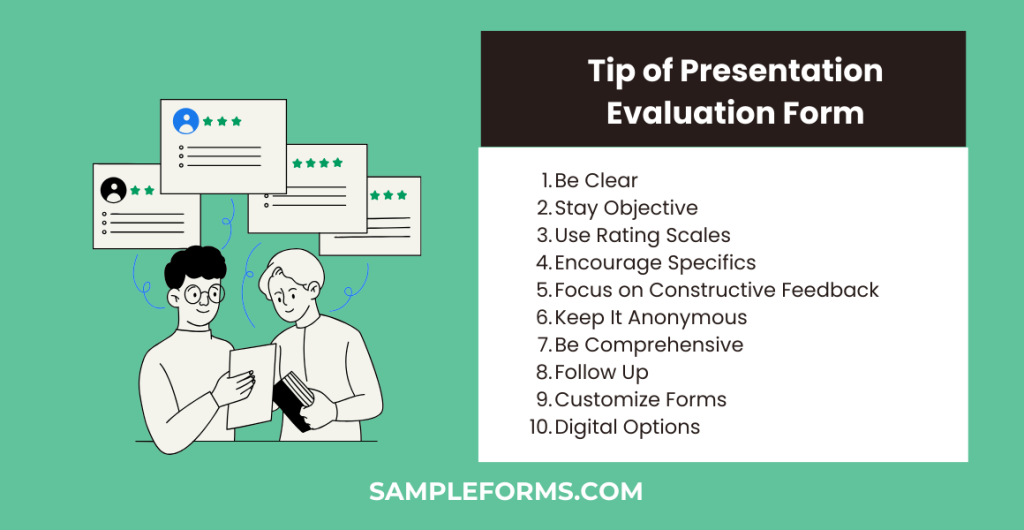
- Be Clear: Define evaluation criteria clearly and concisely.
- Stay Objective: Ensure feedback is objective and based on observable facts.
- Use Rating Scales: Incorporate rating scales for quantifiable feedback.
- Encourage Specifics: Ask for specific examples to support feedback.
- Focus on Constructive Feedback: Emphasize areas for improvement and suggestions.
- Keep It Anonymous: Anonymous feedback can elicit more honest responses.
- Be Comprehensive: Cover content, delivery, visuals, and engagement.
- Follow Up: Use the feedback for discussion and development planning.
- Customize Forms: Tailor forms to the specific presentation type and audience.
- Digital Options: Consider digital forms for ease of collection and analysis.
Can you fail a Pre Employment Physical for being Overweight?
No, being overweight alone typically does not cause failure in a pre-employment physical unless it directly affects job-specific tasks. It’s essential to focus on overall health and ability, similar to assessments in a Mentee Evaluation Form . You should also take a look at our Teacher Evaluation Form
What is usually Included in an Annual Physical Exam?
An annual physical exam typically includes checking vital signs, blood tests, assessments of your organ health, lifestyle discussions, and preventative screenings, mirroring the comprehensive approach of a Sensory Evaluation Form . You should also take a look at our Oral Presentation Evaluation Form
What do you wear to Pre Employment Paperwork?
For pre-employment paperwork, wear business casual attire unless specified otherwise. It shows professionalism, akin to preparing for a Driver Evaluation Form , emphasizing readiness and respect for the process. You should also take a look at our Food Evaluation Form
What does a Pre-employment Physical Consist of?
A pre-employment physical consists of tests measuring physical fitness for the job, including hearing, vision, strength, and possibly drug screening, akin to the tailored approach of a Workshop Evaluation Form . You should also take a look at our Functional Capacity Evaluation Form
Where can I get a Pre Employment Physical Form?
Pre-employment physical forms can be obtained from the hiring organization’s HR department or downloaded from their website, much like how one might access a Sales Evaluation Form for performance review. You should also take a look at our Bid Evaluation Form .
How to get a Pre-employment Physical?
To get a pre-employment physical, contact your prospective employer for the form and details, then schedule an appointment with a healthcare provider who understands the requirements, similar to the process for a Candidate Evaluation Form . You should also take a look at our Customer Service Evaluation Form .
In conclusion, a Presentation Evaluation Form is pivotal for both personal and professional development. Through detailed samples, forms, and letters, this guide empowers users to harness the full benefits of feedback. Whether in debates, presentations, or any public speaking scenario, the Debate Evaluation Form aspect underscores its versatility and significance. Embrace this tool to unlock a new horizon of effective communication and presentation finesse.
Related Posts
Free 8+ sample functional capacity evaluation forms in pdf | ms word, free 9+ sample self evaluation forms in pdf | ms word, free 11+ sample peer evaluation forms in pdf | ms word | excel, free 10+ employee performance evaluation forms in pdf | ms word | excel, free 5+ varieties of sports evaluation forms in pdf, free 8+ sample course evaluation forms in pdf | ms word | excel, free 8+ website evaluation forms in pdf | ms word, free 9+ sample marketing evaluation forms in pdf | ms word, free 11+ internship evaluation forms in pdf | excel | ms word, free 14+ retreat evaluation forms in pdf, free 9+ training evaluation forms in pdf | ms word, free 9+ conference evaluation forms in ms word | pdf | excel, free 3+ construction employee evaluation forms in pdf | ms word, free 20+ sample training evaluation forms in pdf | ms word | excel, free 21+ training evaluation forms in ms word, 7+ seminar evaluation form samples - free sample, example ..., sample conference evaluation form - 10+ free documents in word ..., evaluation form examples, student evaluation form samples - 9+ free documents in word, pdf.
How to Give Effective Presentation Feedback
A conversation with sam j. lubner, md, facp.
Giving an effective scientific presentation, like all public speaking, is an acquired skill that takes practice to perfect. When delivered successfully, an oral presentation can be an invaluable opportunity to showcase your latest research results among your colleagues and peers. It can also promote attendee engagement and help audience members retain the information being presented, enhancing the educational benefit of your talk, according to Sam J. Lubner, MD, FACP , Associate Professor of Medicine and Program Director, Hematology-Oncology Fellowship, at the University of Wisconsin Carbone Cancer Center, and a member of ASCO’s Education Council.

Sam J. Lubner, MD, FACP
In 2019, the Education Council launched a pilot program to provide a group of selected speakers at the ASCO Annual Meeting with feedback on their presentations. Although some of the reviewers, which included members of the Education Council and Education Scholars Program, as well as ASCO’s program directors, conveyed information to the presenters that was goal-referenced, tangible, transparent, actionable, specific, and personalized—the hallmarks of effective feedback—others provided comments that were too vague to improve the speaker’s performance, said Dr. Lubner. For example, they offered comments such as “Great session” or “Your slides were too complicated,” without being specific about what made the session “great” or the slides “too complicated.”
“Giving a presentation at a scientific meeting is different from what we were trained to do. We’re trained to take care of patients, and while we do have some training in presentation, it usually centers around how to deliver clinical information,” said Dr. Lubner. “What we are trying to do with the Education Council’s presentation feedback project is to apply evidence-based methods for giving effective feedback to make presentations at ASCO’s Annual Meeting, international meetings, symposia, and conferences more clinically relevant and educationally beneficial.”
GUEST EDITOR
The ASCO Post talked with Dr. Lubner about how to give effective feedback and how to become a more effective presenter.
Defining Effective Feedback
Feedback is often confused with giving advice, praise, and evaluation, but none of these descriptions are exactly accurate. What constitutes effective feedback?
When I was looking over the literature on feedback to prepare myself on how to give effective feedback to the medical students and residents I oversee, I was amazed to find the information is largely outdated. For example, recommendations in the 1980s and 1990s called for employing the “sandwich” feedback method, which involves saying something positive, then saying what needs to be improved, and then making another positive remark. But that method is time-intensive, and it feels disingenuous to me.
What constitutes helpful feedback to me is information that is goal-referenced, actionable, specific, and has immediate impact. It should be constructive, descriptive, and nonjudgmental. After I give feedback to a student or resident, my next comments often start with a self-reflective question, “How did that go?” and that opens the door to further discussion. The mnemonic I use to provide better feedback and achieve learning goals is SMART: specific, measurable, achievable, realistic, and timely, as described here:
- Specific: Avoid using ambiguous language, for example, “Your presentation was great.” Be specific about what made the presentation “great,” such as, “Starting your presentation off with a provocative question grabbed my attention.”
- Measurable: Suggest quantifiable objectives to meet so there is no uncertainty about what the goals are. For example, “Next time, try a summary slide with one or two take-home points for the audience.”
- Achievable: The goal of the presentation should be attainable. For example, “Trim your slides to no more than six lines per slide and no more than six words per line; otherwise, you are just reading your slides.”
- Realistic: The feedback you give should relate to the goal the presenter is trying to achieve. For example, “Relating the research results back to an initial case presentation will solidify the take-home point that for cancer x, treatment y is the best choice.”
- Timely: Feedback given directly after completion of the presentation is more effective than feedback provided at a later date.
The ultimate goal of effective feedback is to help the presenter become more adept at relaying his or her research in an engaging and concise way, to maintain the audience’s attention and ensure that they retain the information presented.
“Giving a presentation at a scientific meeting is different from what we were trained to do.” — Sam J. Lubner, MD, FACP Tweet this quote
Honing Your Communication Skills
What are some specific tips on how to give effective feedback?
There are five tips that immediately come to mind: (1) focus on description rather than judgment; (2) focus on observation rather than inference; (3) focus on observable behaviors; (4) share both positive and constructive specific points of feedback with the presenter; and (5) focus on the most important points to improve future presentations.
Becoming a Proficient Presenter
How can ASCO faculty become more proficient at delivering their research at the Annual Meeting and at ASCO’s thematic meetings?
ASCO has published faculty guidelines and best practices to help speakers immediately involve an audience in their presentation and hold their attention throughout the talk. They include the following recommendations:
- Be engaging. Include content that will grab the audience’s attention early. For example, interesting facts, images, or a short video to hold the audience’s focus.
- Be cohesive and concise. When preparing slides, make sure the presentation has a clear and logical flow to it, from the introduction to its conclusion. Establish key points and clearly define their importance and impact in a concise, digestible manner.
- Include take-home points. Speakers should briefly summarize key findings from their research and ensure that their conclusion is fully supported by the data in their presentation. If possible, they should provide recommendations or actions to help solidify their message. Thinking about and answering this question—if the audience remembers one thing from my presentation, what do I want it to be?—will help speakers focus their presentation.
- When it comes to slide design, remember, less is more. It’s imperative to keep slides simple to make an impact on the audience.
Another method to keep the audience engaged and enhance the educational benefit of the talk is to use the Think-Pair ( ± Share) strategy, by which the speaker asks attendees to think through questions using two to three steps. They include:
- Think independently about the question that has been posed, forming ideas.
- Pair to discuss thoughts, allowing learners to articulate their ideas and to consider those of others.
- Share (as a pair) the ideas with the larger group.
The value of this exercise is that it helps participants retain the information presented, encourages individual participation, and refines ideas and knowledge through collaboration.
RECOMMENDATIONS FOR SLIDE DESIGN
- Have a single point per line.
- Use < 6 words per line.
- Use < 6 lines per slide.
- Use < 30 characters per slide.
- Use simple words.
- When using tables, maintain a maximum of 6 rows and 6 columns.
- Avoid busy graphics or tables. If you find yourself apologizing to the audience because your slide is too busy, it’s a bad slide and should not be included in the presentation.
- Use cues, not full thoughts, to make your point.
- Keep to one slide per minute as a guide to the length of the presentation.
- Include summary/take-home points per concept. We are all physicians who care about our patients and believe in adhering to good science. Highlight the information you want the audience to take away from your presentation and how that information applies to excellent patient care.
Speakers should also avoid using shorthand communication or dehumanizing language when describing research results. For example, do not refer to patients as a disease: “The study included 250 EGFR mutants.” Say instead, “The study included 250 patients with EGFR -mutant tumors.” And do not use language that appears to blame patients when their cancer progresses after treatment, such as, “Six patients failed to respond to [study drug].” Instead say, “Six patients had tumors that did not respond to [study drug].”
We all have respect for our patients, families, and colleagues, but sometimes our language doesn’t reflect that level of respect, and we need to be more careful and precise in the language we use when talking with our patients and our colleagues.
ASCO has developed a document titled “The Language of Respect” to provide guidance on appropriate respectful language to use when talking with patients, family members, or other health-care providers and when giving presentations at the Annual Meeting and other ASCO symposia. Presenters should keep these critical points in mind and put them into practice when delivering research data at these meetings. ■
DISCLOSURE: Dr. Lubner has been employed by Farcast Biosciences and has held a leadership role at Farcast Biosciences.
FDA Approves Lu-177 Dotatate for Pediatric Patients With GEP-NETs
Ai model may help predict treatment responses select most effective cancer therapies in patients with cancer, in-hospital mortality among patients with covid-19 infection, with or without cancer, imaging drug to assist in detection of cancerous tissue following lumpectomy approved, potential protective effects of aspirin against colorectal cancer.

- Editorial Board
- Advertising
- Disclosures
- Privacy Policy
📞 Call Now 800.403.6598 Contact Us - Get Started

No products in the cart.
Collecting Presentation Feedback to Improve Your Skills
Why Is Getting Presentation Feedback So Important?
Collecting presentation feedback is probably low on your list of priorities, especially if you’re terrified of public speaking and not making a fool of yourself in front of a group of people is your biggest concern. But having some sort of response system in place so your audience can provide you with feedback on your presentation is an incredibly useful (not to mention inexpensive) way to improve your public speaking skills and become an even better presenter.
Why is getting presentation feedback so important?
For starters, when people provide you with feedback—even if it’s negative—you know they were paying attention. They were listening and watching, and by telling you what they thought of your presentation, they’re giving you input on your overall message, from what you said to how you said it .
That’s powerful information; it’s the best way for you to know if your presentation is doing what you want it to, whether that’s to inform, persuade, or motivate other people. Who better to tell you than the people in your audience?
Choose The Right Response System
Despite its usefulness, speakers continue to pass up the opportunity to poll audiences to get their feedback on a presentation. Certainly, no one wants to feel rejected or be told their presentation was terrible, but wouldn’t you rather be told your presentation missed the mark, than to continue delivering bad presentations that don’t engage audiences?
Not only that, but without presentation feedback, a speaker is forced to self-evaluate. Some will be overly-critical while others will be self-congratulatory—neither of which are beneficial or inspire the speaker to get better.
Offer a Presentation Feedback Form
In our Presentation Skills Training workshops, we talk about the importance of making a connection with the audience, and that connection doesn’t need to end with the presentation.
An immediate response system, such as providing your audience with a presentation feedback form to fill in and return at the end of the presentation is one way to gauge your performance. You can also encourage audience members to use other methods to provide feedback, such as directly to you through temp email , on social media, or online on Google or Yelp. This way, they’re not only helping you by rating your presentation, but their positive reviews will bolster your reputation, which will encourage others to work with you. And they’re staying connected with you beyond the presentation.
If the thought of having people “judge” your presentation frightens you, think about how getting positive feedback will make you feel. If you’re someone who lacks confidence or tends to be self-critical of your performance, hearing others tell you your presentation was inspiring or enjoyable can go a long way to helping you overcome your feelings of inadequacy.
Using Presentation Feedback to Achieve Your Goals
Whatever the situation that’s brought you to the podium—whether you’re a keynote speaker at a fundraiser or delivering a sales pitch—getting presentation feedback can be energizing. Consider how you feel when a manager or co-worker congratulates you on a job well done. You feel invigorated and motived to continue doing a good job that gets recognized.
The same is true of positive presentation feedback: When you know you’ve achieved your goal of connecting with an audience , you’re motivated to keep making those connections—and make them even better.
So what should your presentation feedback form (or other response system) look like? That’s up to you. But however you decide to collect presentation feedback, use the comments you receive to:
- Assess what you are doing well and where you need to improve
- Understand how your message is being received by others
- Direct you toward achieving your goals (e.g., increase your number of sales)
Not All Feedback is Bad
The term ‘feedback’ has earned a bad rap with some people. They hear it and run because they’re afraid someone will say something negative about them.
Not all feedback is negative, and not all of it is positive. But it should always be constructive, and as a public speaker you should want to hear it all. It’s the best way to know what your audience is getting from your presentation so you can improve your public speaking skills.
Do you provide opportunities for your audiences to give feedback? Tell us about it in the comment section or find us on social media and bring the conversation there. We’re on Facebook , Twitter , Google+ and LinkedIn .
16 Comments
I joined Toastmasters a year ago and have had some good feedback and some not so good. Some of the members were in my shoes, really not sure how to evaluate my presentations very well. Feedback is great but I guess it depends on the person giving the feedback.
Self evaluation is always hard to do. I’m a firm believer in having another person critique your work- it’s an opportunity to learn more about yourself!
Good post! I also had a bad feeling about the feedback until I read this post. I’ll be definitely using feedback form next time. I might still feel a bit uneasy, though.
I would like to get some professional feedback on my delivery. I think I will have someone video my presentation and send it to you guys to evaluate it.
I am a corporate trainer and give presentation feedback to our managers. Most of our folks really appreciate having good feedback so they can make their next presentations better.
Soliciting feedback is scary but necessary if you want to improve and I do…very scary though. Good article
Since I have written feedback forms for companies myself, I know how they work.But reading this blog set me thinking as to how it helps the presenter. I agree with the author that feedback, whether good or bad, definitely helps us in evaluating oneself.
Yes. I agree with everyone who says feedback can be scary-but it can also be helpful. The key is getting people to use constructive criticism. You are also going to have to get used to the occasional remarks from someone who is just being spiteful. Learn to recognize constructive criticism and take it to heart.
I used to take all feedback as negative. I wasn’t able to differentiate “bad” from “constructive”. This greatly hurt me in the workforce and I actually lost my first job fresh from college over it. I have come a long way but I am still learning and things like this help me a lot. Public speaking on any level has never been easy for me but I have always been way too hard on myself. I see that now.
I have never had anybody give me any feedback on my presentations.
One of the cardinal characters of people who want to succeed is the courage to accept valid criticism. Feedbacks must not be good but it is a necessity that will help to know if you rea making progress
Great feedback is absolutely essential to one’s ability to polish one’s skills even as an experienced speaker. Without it, we are unable to assess our strengths and growth opportunities along the way. Who wants to fall into a rut and never improve when called upon to speak? I would say no one which is why feedback is a must for both amateur and experienced speakers.
Good article. Very knowledgeable and informative. I would like to read new articles related to this! I Would also like you to read our articles related personality development and mental health.
Good article. Very knowledgeable and informative.
Your article provides helpful tips on how to collect feedback to improve our presentation skills.
good bro. Thx!
Leave a Reply Cancel reply
Your email address will not be published. Required fields are marked *
Save my name, email, and website in this browser for the next time I comment.
Cookie consent
We use our own and third-party cookies to show you more relevant content based on your browsing and navigation history. Please accept or manage your cookie settings below. Here's our cookie policy

- Form Builder Signups and orders
- Survey maker Research and feedback
- Quiz Maker Trivia and product match
- Find Customers Generate more leads
- Get Feedback Discover ways to improve
- Do research Uncover trends and ideas
- Marketers Forms for marketing teams
- Product Forms for product teams
- HR Forms for HR teams
- Customer success Forms for customer success teams
- Business Forms for general business
- Form templates
- Survey templates
- Quiz templates
- Poll templates
- Order forms
- Feedback forms
- Satisfaction surveys
- Application forms
- Feedback surveys
- Evaluation forms
- Request forms
- Signup forms
- Business surveys
- Marketing surveys
- Report forms
- Customer feedback form
- Registration form
- Branding questionnaire
- 360 feedback
- Lead generation
- Contact form
- Signup sheet
- Help center Find quick answers
- Contact us Speak to someone
- Our blog Get inspired
- Our community Share and learn
- Our guides Tips and how-to
- Updates News and announcements
- Brand Our guidelines
- Partners Browse or join
- Careers Join our team
- All templates
- → Feedback forms
- → Presentation Feedback Form Template

Presentation Feedback Form Template
Use this free template to get actionable feedback on your presentation—from the content to the delivery.
Rated 4.5 out of 600+ reviews on G2.com
Ask the right questions, get the right feedback
Customize your presentation feedback form template and up your game as a speaker.
Presentation feedback form FAQs:
How do i make my presentation feedback form personal.
When making a form, it's super easy to forget your common courtesies. Thank people for their time–it goes a long way.
And hey, it never hurts to inject a bit of life into your forms. If you know your sense of humor goes down well in your presentations, it will likely work in your feedback form too. A little joke, and even some sass, can leave a lasting impression.
How can I use forms to improve as a presenter?
It's no good leaving your form responses up there in the cloud gathering cosmic dust. You can integrate with ReportGorilla to visualize your weak points and focus on pulling those numbers up in the future.
Make sure your presentation feedback form also includes a free-form comment box. This will allow participants to give feedback on something you might not have thought to ask about, and provide insights that can help you level up as a speaker.
Make life easy with integrations

Google Sheets
Google Analytics

Here's what people say about us
Form builders are as old as the web, but Typeform elevates the medium substantially. Johnny Rodgers Product Architect
We’ve received 3x the responses using Typeform than from a professionally commissioned market research study Kate Donhoe Head of Product Marketing
Leads from the Typeform integration were twice as likely to convert. Tobias Wasmer Marketing Manager @ Volvo Cars
You used to need developers to do all this. Not anymore. Kyle Maltz Chief Operating Officer
Typeform is a production-grade system for our entire growth funnel. Gaurav Vohra Head of Growth
Typeform helps me attract more responses and a higher response rate than other tools. Rand Fishkin CEO + Founder
Presentation feedback form not right?
1500+ Templates, 120+ Integrations

Online Order Form Template
Sell products and vouchers online with a custom order form

Job Requisition Form Template
Speed up the hiring process with this internal request form for managers

Reference Request Form Template
Get the lowdown on candidates with this interactive reference request form

monday.com Form Template
Power-up your workflow with our newest integration

Lead Generation Form Template
Get more leads—looks great on any device
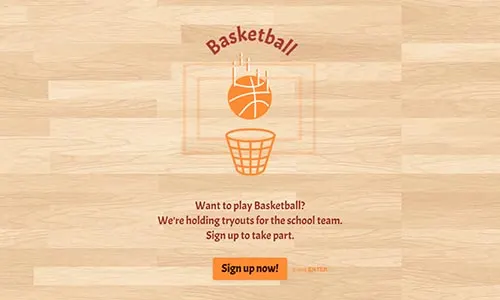
Signup Sheet Template
A fun, friendly way to ask people for information
Other categories used by people like you
Presentation Feedback Form Template
Learn how effective your presentations are and how to improve them.
Gather feedback about your presentation from your participants to help you improve your public speaking skills and understand whether your audience learned what you wanted them to learn.
Use a presentation feedback form to gather insights from your audience about your slides and lecture. It will help you understand whether they learned what you wanted them to learn and improve your presentation for the next time. Following are some tips you can use to build an effective feedback form for any presentation.
Why Ask For Feedback on Your Presentations?
There’s a lot of material out there that can teach you how to build and deliver a good presentation . But if you want to make your presentation great you need to present it many times, gather feedback, and hone it accordingly. Your audience can tell you whether they learned what you wanted them to learn. They can tell you if you motivated them and made them think. Of course, they can also tell you if you lost them, and where. But that’s great too. After all, every piece of feedback is an opportunity to grow and improve.
While nobody likes to hear bad feedback, it can really help you sharpen your presentation and public speaking skills for the future. Plus, you’re likely to receive some positive feedback as well. The key to receiving helpful and constructive feedback is asking the right questions in the right way. Here are some tips to help you do exactly that.

How to Ask for Feedback on Your Presentation?
You can request feedback in many different ways, each has its advantages and setbacks. For example, you can ask in person or hand out paper forms at the end of your talk. Today, however, we’re going to take a look at online feedback forms and show you how to build a form that is super effective for you and convenient for your audience. Use the tips below to create and administer your perfect presentation feedback form.
Timing Is Everything
Deciding when to share your feedback form will influence the amount of feedback you receive as well as its quality and relevance. In most cases, the best time to ask for feedback is right after the presentation. That’s when the presentation is still fresh in your audience’s minds, allowing them to offer the most accurate feedback. It is also when they are most likely to respond as they are still engaged in the experience and haven’t yet moved on to the rest of their day. So, consider dedicating the last few minutes of your talk to asking for feedback.

There Are Many Sides to Every Presentation
While you don’t want to ask too many questions, you should cover all aspects of the talk you just gave. Include questions about your presentation deck. For example, “did the presentation aid or hinder the talk?” or “would you like to receive the deck after the presentation?” Ask about yourself as a speaker. For instance, “did the lecturer seem knowledgeable about the subject matter?”. And don’t forget to inquire about the content as well. For example: “did you learn something new from this presentation?” or “what were your main takeaways?”.
Good Questions Yield Constructive Answers
Feedback can be discouraging or inspiring. You may think the nature of the feedback you receive depends on your respondents, but actually, it’s in your hands. Your questions can direct them toward the type of feedback you want to receive. Ask questions that focus on improvement and clarity, not on criticism. For example, ask “what would make the presentation even better?” as opposed to “what didn’t you like about the presentation?”.

A Feedback Form Is a Journey
Whether you create your form from scratch or build on one of our form templates , consider your audience throughout the form design process. Ask yourself how you can keep them engaged from the first question to the last. Think about what could evoke deep thought and creativity in their answers.
Decide on a logical structure for your form. You could start with questions about their general experience and move into details, or separate between content and form. Or you could have a section about the speaker, another about the deck, and another about audience participation. There are many options, just make sure it makes sense and invites your respondents to enter a thought process. You’ll also want to move gradually from easier closed-ended questions to more challenging open-ended questions.

Clarity Is Key
A good feedback form is a clear feedback form. So, make sure your questions are simple and easy to understand. Look out for double meanings that could confuse your audience. Make sure you’re not asking any double-barreled questions , like “was the speaker knowledgeable and confident?”. They’re difficult to answer accurately.
Use images to further clarify your intentions. They’ll also add some color and increase engagement. Additionally, try to make your feedback form as concise as possible. Short and simple is the best way to ensure you receive lots of high-quality feedback, which you definitely deserve!
So, What’s Next?
Now that you know how to build a useful presentation feedback form, it’s time to schedule your next speaking engagement. It will be a great opportunity to test your form and collect some great feedback. We hope our template will help you get started. Feel free to change and improve it so that it best suits the subject, goals, and audience of your presentation.
People who viewed Presentation Feedback Form also viewed

You can easily do it yourself
Share the template link

Center for Excellence in Teaching
Home > Resources > Peer feedback form for group presentations
Peer feedback form for group presentations
A sample form for use by students when they are observing other students’ class presentations, focusing on constructive suggestions for improvement.
Download this file
Download this file [61.44 KB]
Back to Resources Page

- Find a Club
- Start a Club
- Toggle Search
- / Resources
- / Evaluation and Feedback-Evaluation Resource 1
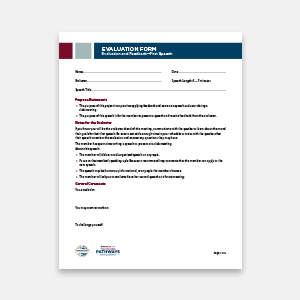
Evaluation and Feedback-Evaluation Resource 1
This evaluation resource is for the first speech in the “Evaluation and Feedback” project. Use it in your club to evaluate a member completing this project. You can download and complete the resource on your device, or print and complete it by hand. How you choose to complete the evaluation depends on your preference and the preference of the member you are evaluating.
Numbers, Facts and Trends Shaping Your World
Read our research on:
Full Topic List
Regions & Countries
- Publications
- Our Methods
- Short Reads
- Tools & Resources
Read Our Research On:
Table of Contents
Mobile phone ownership over time, who owns cellphones and smartphones, smartphone dependency over time, who is smartphone dependent, find out more, mobile fact sheet.
Large shares of Americans are connected to the world of digital information while “on the go” via smartphones and other mobile devices. Explore the patterns and trends that have shaped the mobile revolution below.
To better understand Americans’ smartphone and broadband adoption, Pew Research Center surveyed 5,733 U.S. adults from May 19 to Sept. 5, 2023. Ipsos conducted this National Public Opinion Reference Survey (NPORS) for the Center using address-based sampling and a multimode protocol that included both web and mail. This way nearly all U.S. adults have a chance of selection. The survey is weighted to be representative of the U.S. adult population by gender, race and ethnicity, education and other categories.
Polls from 2000 to 2021 were conducted via phone. For more on this mode shift, please read our Q&A .
Here are the questions used for this analysis , along with responses, and its methodology .
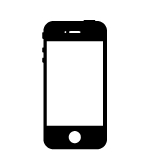
The vast majority of Americans – 97% – now own a cellphone of some kind. Nine-in-ten own a smartphone, up from just 35% in Pew Research Center’s first survey of smartphone ownership conducted in 2011.
Note: The vertical line indicates a change in mode. Polls from 2002-2021 were conducted via phone. In 2023, the poll was conducted via web and mail. For more details on this shift, please read our Q&A . Refer to the topline for more information on how question wording varied over the years. Respondents who did not give an answer are not shown.
Source: Surveys of U.S. adults conducted 2002-2023.
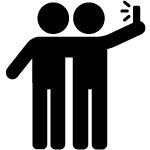
Substantial majorities of Americans across a wide range of demographic groups are cellphone owners. The same is true for smartphone ownership – though some differences do emerge, particularly by age, household income and level of formal education.
% of U.S. adults who say they own a __, by …
- RACE & ETHNICITY
- POLITICAL AFFILIATION

Today, 15% of U.S. adults are “smartphone-only” internet users – meaning they own a smartphone, but do not have home broadband service.
Source: Surveys of U.S. adults conducted 2013-2023. Data for each year is based on a pooled analysis of all surveys containing broadband and smartphone questions fielded during that year.
Reliance on smartphones for online access is especially common among Americans with lower household incomes and those with lower levels of formal education.

This fact sheet was compiled by Research Assistant Olivia Sidoti , with help from Research Analyst Risa Gelles-Watnick , Research Analyst Michelle Faverio , Digital Producer Sara Atske , Associate Information Graphics Designer Kaitlyn Radde and Temporary Researcher Eugenie Park .
Follow these links for more in-depth analysis of the impact of mobile technology on American life.
- Americans’ Social Media Use Jan. 31, 2024
- Americans’ Use of Mobile Technology and Home Broadband Jan. 31 2024
- Q&A: How and why we’re changing the way we study tech adoption Jan. 31, 2024
Find more reports and blog posts related to internet and technology .
1615 L St. NW, Suite 800 Washington, DC 20036 USA (+1) 202-419-4300 | Main (+1) 202-857-8562 | Fax (+1) 202-419-4372 | Media Inquiries
Research Topics
- Age & Generations
- Coronavirus (COVID-19)
- Economy & Work
- Family & Relationships
- Gender & LGBTQ
- Immigration & Migration
- International Affairs
- Internet & Technology
- Methodological Research
- News Habits & Media
- Non-U.S. Governments
- Other Topics
- Politics & Policy
- Race & Ethnicity
- Email Newsletters
ABOUT PEW RESEARCH CENTER Pew Research Center is a nonpartisan fact tank that informs the public about the issues, attitudes and trends shaping the world. It conducts public opinion polling, demographic research, media content analysis and other empirical social science research. Pew Research Center does not take policy positions. It is a subsidiary of The Pew Charitable Trusts .
Copyright 2024 Pew Research Center
Terms & Conditions
Privacy Policy
Cookie Settings
Reprints, Permissions & Use Policy
Our approach
- Responsibility
- Infrastructure
- Try Meta AI
RECOMMENDED READS
- 5 Steps to Getting Started with Llama 2
- The Llama Ecosystem: Past, Present, and Future
- Introducing Code Llama, a state-of-the-art large language model for coding
- Meta and Microsoft Introduce the Next Generation of Llama
- Today, we’re introducing Meta Llama 3, the next generation of our state-of-the-art open source large language model.
- Llama 3 models will soon be available on AWS, Databricks, Google Cloud, Hugging Face, Kaggle, IBM WatsonX, Microsoft Azure, NVIDIA NIM, and Snowflake, and with support from hardware platforms offered by AMD, AWS, Dell, Intel, NVIDIA, and Qualcomm.
- We’re dedicated to developing Llama 3 in a responsible way, and we’re offering various resources to help others use it responsibly as well. This includes introducing new trust and safety tools with Llama Guard 2, Code Shield, and CyberSec Eval 2.
- In the coming months, we expect to introduce new capabilities, longer context windows, additional model sizes, and enhanced performance, and we’ll share the Llama 3 research paper.
- Meta AI, built with Llama 3 technology, is now one of the world’s leading AI assistants that can boost your intelligence and lighten your load—helping you learn, get things done, create content, and connect to make the most out of every moment. You can try Meta AI here .
Today, we’re excited to share the first two models of the next generation of Llama, Meta Llama 3, available for broad use. This release features pretrained and instruction-fine-tuned language models with 8B and 70B parameters that can support a broad range of use cases. This next generation of Llama demonstrates state-of-the-art performance on a wide range of industry benchmarks and offers new capabilities, including improved reasoning. We believe these are the best open source models of their class, period. In support of our longstanding open approach, we’re putting Llama 3 in the hands of the community. We want to kickstart the next wave of innovation in AI across the stack—from applications to developer tools to evals to inference optimizations and more. We can’t wait to see what you build and look forward to your feedback.
Our goals for Llama 3
With Llama 3, we set out to build the best open models that are on par with the best proprietary models available today. We wanted to address developer feedback to increase the overall helpfulness of Llama 3 and are doing so while continuing to play a leading role on responsible use and deployment of LLMs. We are embracing the open source ethos of releasing early and often to enable the community to get access to these models while they are still in development. The text-based models we are releasing today are the first in the Llama 3 collection of models. Our goal in the near future is to make Llama 3 multilingual and multimodal, have longer context, and continue to improve overall performance across core LLM capabilities such as reasoning and coding.
State-of-the-art performance
Our new 8B and 70B parameter Llama 3 models are a major leap over Llama 2 and establish a new state-of-the-art for LLM models at those scales. Thanks to improvements in pretraining and post-training, our pretrained and instruction-fine-tuned models are the best models existing today at the 8B and 70B parameter scale. Improvements in our post-training procedures substantially reduced false refusal rates, improved alignment, and increased diversity in model responses. We also saw greatly improved capabilities like reasoning, code generation, and instruction following making Llama 3 more steerable.

*Please see evaluation details for setting and parameters with which these evaluations are calculated.
In the development of Llama 3, we looked at model performance on standard benchmarks and also sought to optimize for performance for real-world scenarios. To this end, we developed a new high-quality human evaluation set. This evaluation set contains 1,800 prompts that cover 12 key use cases: asking for advice, brainstorming, classification, closed question answering, coding, creative writing, extraction, inhabiting a character/persona, open question answering, reasoning, rewriting, and summarization. To prevent accidental overfitting of our models on this evaluation set, even our own modeling teams do not have access to it. The chart below shows aggregated results of our human evaluations across of these categories and prompts against Claude Sonnet, Mistral Medium, and GPT-3.5.

Preference rankings by human annotators based on this evaluation set highlight the strong performance of our 70B instruction-following model compared to competing models of comparable size in real-world scenarios.
Our pretrained model also establishes a new state-of-the-art for LLM models at those scales.

To develop a great language model, we believe it’s important to innovate, scale, and optimize for simplicity. We adopted this design philosophy throughout the Llama 3 project with a focus on four key ingredients: the model architecture, the pretraining data, scaling up pretraining, and instruction fine-tuning.
Model architecture
In line with our design philosophy, we opted for a relatively standard decoder-only transformer architecture in Llama 3. Compared to Llama 2, we made several key improvements. Llama 3 uses a tokenizer with a vocabulary of 128K tokens that encodes language much more efficiently, which leads to substantially improved model performance. To improve the inference efficiency of Llama 3 models, we’ve adopted grouped query attention (GQA) across both the 8B and 70B sizes. We trained the models on sequences of 8,192 tokens, using a mask to ensure self-attention does not cross document boundaries.
Training data
To train the best language model, the curation of a large, high-quality training dataset is paramount. In line with our design principles, we invested heavily in pretraining data. Llama 3 is pretrained on over 15T tokens that were all collected from publicly available sources. Our training dataset is seven times larger than that used for Llama 2, and it includes four times more code. To prepare for upcoming multilingual use cases, over 5% of the Llama 3 pretraining dataset consists of high-quality non-English data that covers over 30 languages. However, we do not expect the same level of performance in these languages as in English.
To ensure Llama 3 is trained on data of the highest quality, we developed a series of data-filtering pipelines. These pipelines include using heuristic filters, NSFW filters, semantic deduplication approaches, and text classifiers to predict data quality. We found that previous generations of Llama are surprisingly good at identifying high-quality data, hence we used Llama 2 to generate the training data for the text-quality classifiers that are powering Llama 3.
We also performed extensive experiments to evaluate the best ways of mixing data from different sources in our final pretraining dataset. These experiments enabled us to select a data mix that ensures that Llama 3 performs well across use cases including trivia questions, STEM, coding, historical knowledge, etc.
Scaling up pretraining
To effectively leverage our pretraining data in Llama 3 models, we put substantial effort into scaling up pretraining. Specifically, we have developed a series of detailed scaling laws for downstream benchmark evaluations. These scaling laws enable us to select an optimal data mix and to make informed decisions on how to best use our training compute. Importantly, scaling laws allow us to predict the performance of our largest models on key tasks (for example, code generation as evaluated on the HumanEval benchmark—see above) before we actually train the models. This helps us ensure strong performance of our final models across a variety of use cases and capabilities.
We made several new observations on scaling behavior during the development of Llama 3. For example, while the Chinchilla-optimal amount of training compute for an 8B parameter model corresponds to ~200B tokens, we found that model performance continues to improve even after the model is trained on two orders of magnitude more data. Both our 8B and 70B parameter models continued to improve log-linearly after we trained them on up to 15T tokens. Larger models can match the performance of these smaller models with less training compute, but smaller models are generally preferred because they are much more efficient during inference.
To train our largest Llama 3 models, we combined three types of parallelization: data parallelization, model parallelization, and pipeline parallelization. Our most efficient implementation achieves a compute utilization of over 400 TFLOPS per GPU when trained on 16K GPUs simultaneously. We performed training runs on two custom-built 24K GPU clusters . To maximize GPU uptime, we developed an advanced new training stack that automates error detection, handling, and maintenance. We also greatly improved our hardware reliability and detection mechanisms for silent data corruption, and we developed new scalable storage systems that reduce overheads of checkpointing and rollback. Those improvements resulted in an overall effective training time of more than 95%. Combined, these improvements increased the efficiency of Llama 3 training by ~three times compared to Llama 2.
Instruction fine-tuning
To fully unlock the potential of our pretrained models in chat use cases, we innovated on our approach to instruction-tuning as well. Our approach to post-training is a combination of supervised fine-tuning (SFT), rejection sampling, proximal policy optimization (PPO), and direct preference optimization (DPO). The quality of the prompts that are used in SFT and the preference rankings that are used in PPO and DPO has an outsized influence on the performance of aligned models. Some of our biggest improvements in model quality came from carefully curating this data and performing multiple rounds of quality assurance on annotations provided by human annotators.
Learning from preference rankings via PPO and DPO also greatly improved the performance of Llama 3 on reasoning and coding tasks. We found that if you ask a model a reasoning question that it struggles to answer, the model will sometimes produce the right reasoning trace: The model knows how to produce the right answer, but it does not know how to select it. Training on preference rankings enables the model to learn how to select it.
Building with Llama 3
Our vision is to enable developers to customize Llama 3 to support relevant use cases and to make it easier to adopt best practices and improve the open ecosystem. With this release, we’re providing new trust and safety tools including updated components with both Llama Guard 2 and Cybersec Eval 2, and the introduction of Code Shield—an inference time guardrail for filtering insecure code produced by LLMs.
We’ve also co-developed Llama 3 with torchtune , the new PyTorch-native library for easily authoring, fine-tuning, and experimenting with LLMs. torchtune provides memory efficient and hackable training recipes written entirely in PyTorch. The library is integrated with popular platforms such as Hugging Face, Weights & Biases, and EleutherAI and even supports Executorch for enabling efficient inference to be run on a wide variety of mobile and edge devices. For everything from prompt engineering to using Llama 3 with LangChain we have a comprehensive getting started guide and takes you from downloading Llama 3 all the way to deployment at scale within your generative AI application.
A system-level approach to responsibility
We have designed Llama 3 models to be maximally helpful while ensuring an industry leading approach to responsibly deploying them. To achieve this, we have adopted a new, system-level approach to the responsible development and deployment of Llama. We envision Llama models as part of a broader system that puts the developer in the driver’s seat. Llama models will serve as a foundational piece of a system that developers design with their unique end goals in mind.

Instruction fine-tuning also plays a major role in ensuring the safety of our models. Our instruction-fine-tuned models have been red-teamed (tested) for safety through internal and external efforts. Our red teaming approach leverages human experts and automation methods to generate adversarial prompts that try to elicit problematic responses. For instance, we apply comprehensive testing to assess risks of misuse related to Chemical, Biological, Cyber Security, and other risk areas. All of these efforts are iterative and used to inform safety fine-tuning of the models being released. You can read more about our efforts in the model card .
Llama Guard models are meant to be a foundation for prompt and response safety and can easily be fine-tuned to create a new taxonomy depending on application needs. As a starting point, the new Llama Guard 2 uses the recently announced MLCommons taxonomy, in an effort to support the emergence of industry standards in this important area. Additionally, CyberSecEval 2 expands on its predecessor by adding measures of an LLM’s propensity to allow for abuse of its code interpreter, offensive cybersecurity capabilities, and susceptibility to prompt injection attacks (learn more in our technical paper ). Finally, we’re introducing Code Shield which adds support for inference-time filtering of insecure code produced by LLMs. This offers mitigation of risks around insecure code suggestions, code interpreter abuse prevention, and secure command execution.
With the speed at which the generative AI space is moving, we believe an open approach is an important way to bring the ecosystem together and mitigate these potential harms. As part of that, we’re updating our Responsible Use Guide (RUG) that provides a comprehensive guide to responsible development with LLMs. As we outlined in the RUG, we recommend that all inputs and outputs be checked and filtered in accordance with content guidelines appropriate to the application. Additionally, many cloud service providers offer content moderation APIs and other tools for responsible deployment, and we encourage developers to also consider using these options.
Deploying Llama 3 at scale
Llama 3 will soon be available on all major platforms including cloud providers, model API providers, and much more. Llama 3 will be everywhere .
Our benchmarks show the tokenizer offers improved token efficiency, yielding up to 15% fewer tokens compared to Llama 2. Also, Group Query Attention (GQA) now has been added to Llama 3 8B as well. As a result, we observed that despite the model having 1B more parameters compared to Llama 2 7B, the improved tokenizer efficiency and GQA contribute to maintaining the inference efficiency on par with Llama 2 7B.
For examples of how to leverage all of these capabilities, check out Llama Recipes which contains all of our open source code that can be leveraged for everything from fine-tuning to deployment to model evaluation.
What’s next for Llama 3?
The Llama 3 8B and 70B models mark the beginning of what we plan to release for Llama 3. And there’s a lot more to come.
Our largest models are over 400B parameters and, while these models are still training, our team is excited about how they’re trending. Over the coming months, we’ll release multiple models with new capabilities including multimodality, the ability to converse in multiple languages, a much longer context window, and stronger overall capabilities. We will also publish a detailed research paper once we are done training Llama 3.
To give you a sneak preview for where these models are today as they continue training, we thought we could share some snapshots of how our largest LLM model is trending. Please note that this data is based on an early checkpoint of Llama 3 that is still training and these capabilities are not supported as part of the models released today.

We’re committed to the continued growth and development of an open AI ecosystem for releasing our models responsibly. We have long believed that openness leads to better, safer products, faster innovation, and a healthier overall market. This is good for Meta, and it is good for society. We’re taking a community-first approach with Llama 3, and starting today, these models are available on the leading cloud, hosting, and hardware platforms with many more to come.
Try Meta Llama 3 today
We’ve integrated our latest models into Meta AI, which we believe is the world’s leading AI assistant. It’s now built with Llama 3 technology and it’s available in more countries across our apps.
You can use Meta AI on Facebook, Instagram, WhatsApp, Messenger, and the web to get things done, learn, create, and connect with the things that matter to you. You can read more about the Meta AI experience here .
Visit the Llama 3 website to download the models and reference the Getting Started Guide for the latest list of all available platforms.
You’ll also soon be able to test multimodal Meta AI on our Ray-Ban Meta smart glasses.
As always, we look forward to seeing all the amazing products and experiences you will build with Meta Llama 3.
Our latest updates delivered to your inbox
Subscribe to our newsletter to keep up with Meta AI news, events, research breakthroughs, and more.
Join us in the pursuit of what’s possible with AI.

Product experiences
Foundational models
Latest news
Meta © 2024
- Mobile Forms
- INTEGRATIONS
- See 100+ integrations
- FEATURED INTEGRATIONS
- See more Integrations
- See more CRM Integrations

- See more Storage Integrations
- See more Payment Integrations

- See more Email Integrations
- Jotform Teams
- Enterprise Mobile
- Prefill Forms
- HIPAA Forms
- Secure Forms
- Assign Forms
- Online Payments
- See more features
- Multiple Users
- Admin Console
- White Labeling
- See more Enterprise Features
- Contact Sales
- Contact Support
- Help Center
- Jotform Books
- Jotform Academy
Get a dedicated support team with Jotform Enterprise.
Apply to Jotform Enterprise for a dedicated support team.
- Sign Up for Free
Presentation Peer Feedback Form
A presentation peer feedback form is used by students to give feedback on presentations that their peers have created in the classroom. Whether you teach high school, college, or university, give your students the opportunity to give each other constructive criticism. Collect effective feedback for presentations with a free Presentation Peer Feedback Form. Just customize the form template, embed it on your website, and watch as submissions are automatically sent straight to your Jotform account.
Every presentation is different, so customize your Presentation Peer Feedback Form by changing fonts, colors, and backgrounds with our easy-to-use Form Builder. If you’d like to send responses to your other accounts — such as Google Drive, Dropbox, Box, or Airtable — do it automatically with Jotform’s 100+ free integrations. You can even analyze feedback results with Jotform Tables or Jotform Report Builder! Make the most of your classroom with a free Presentation Peer Feedback Form.
More templates like this
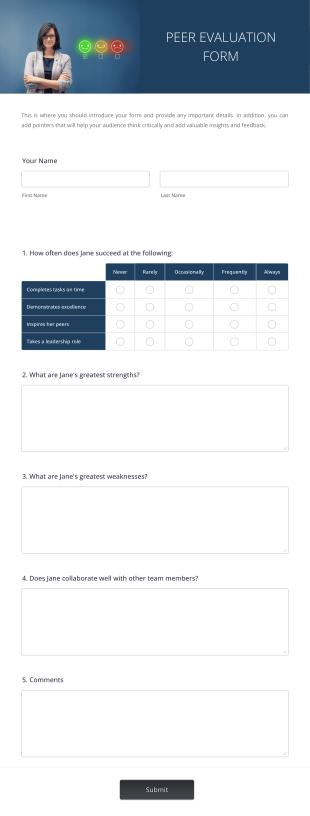
Peer Evaluation
A Peer Evaluation form is a form template designed to streamline the process of collecting feedback and evaluations from peers in the workplace. With this peer feedback form, Human Resources departments can eliminate paperwork and gather all evaluations online. The form includes questions about feedback for success in the job, the person's strengths and weaknesses, and their ability to collaborate with other team members. This form is essential for HR professionals looking to gather comprehensive feedback on employees' performance and foster a culture of continuous improvement within the organization.Jotform, a user-friendly and drag-and-drop online form builder, provides a seamless experience for creating and customizing the Peer Evaluation form. With Jotform's extensive field options and widgets, HR professionals can easily tailor the form to their specific requirements. Additionally, Jotform offers integration capabilities with popular apps and services like Google Drive, Salesforce, and Dropbox, allowing for seamless data transfer and automation. The platform also provides the Jotform Sign feature, which enables users to collect electronic signatures on forms and documents, ensuring enhanced security and compliance. With Jotform's ease of use, ease of -customization, and ease of -collecting e-signatures, HR professionals can streamline their evaluation processes and make more informed decisions based on comprehensive feedback.

Presentation Feedback
Whether you just gave a presentation or were a viewer at a seminar, a presentation feedback form is a great way to collect constructive feedback. Customize the presentation feedback form template to include the presenters name, commentary fields and grading rubrics. Additionally, presentation feedback templates have access to Jotform's collection of themes, apps, and widgets to help user engagement. Use our presentation feedback form sample as a guide for creating your own, customizing it to fit your needs.

Employee Peer Review Template
An employee peer review lets employees evaluate their coworkers’ performance and behavior in the workplace. Use our free, online Employee Peer Review Template to simplify and speed up the evaluation process at your company. Once you’ve customized it to meet your needs, publish the form on your company site or send a direct form link to employees. Your staff will be able to name the employee they’re reviewing, describe the review period, and rate their coworkers on a scale from exceptional to unsatisfactory. Using our drag-and-drop Form Builder, you’re free to change the rating scale however you like. You can view submissions from your Jotform account on any device, even offline with Jotform Mobile Forms.Need to make some changes to our Employee Peer Review Template? With our drag-and-drop Form Builder, you can easily customize this template to perfectly align with your needs — no coding necessary! Feel free to replace the input table with questions or slider rating scales. You can even upload your company’s logo for a more professional look! While you’re at it, sync your Employee Peer Review Form to apps like Google Drive, Dropbox, and Airtable to store evaluations in your other online accounts too. Boost employee performance with a custom Employee Peer Review Template that makes it easier for employees to evaluate their coworkers!
- Form Templates /
- Feedback Forms /
- Peer Feedback Forms /
Peer Feedback Forms
A Peer Evaluation form is a form template designed to streamline the process of collecting feedback and evaluations from peers in the workplace
An Employee Peer Review Template is a form template designed to facilitate the evaluation of coworkers' performance and behavior in the workplace.

Student Peer Evaluation Form
A student peer evaluation form is a tool used by teachers to collect feedback about students from their peers. No coding!

A presentation peer feedback form is used by students to give feedback on presentations that their peers have created in the classroom. Customize and share online.
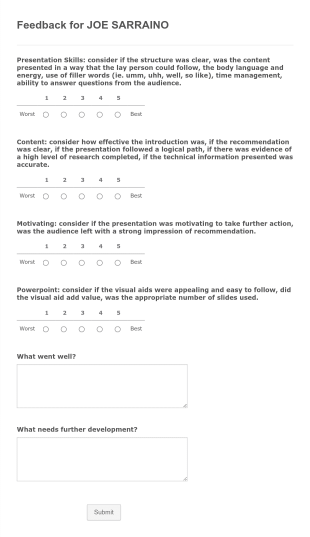
Feedback For SSDP Graduate

SOS Peer Feedback
Feedback form

Feedback Session GLSS
Testing prototype
About Peer Feedback Forms
Whether you need feedback on employee performance reviews or a group project, gather the data you need with Jotform’s free online Peer Feedback Forms. Start by choosing a free template below and customizing it with no coding required — then embed the form in your website or share it with a link to start collecting feedback from your peers on any device. All responses are stored in your secure Jotform account.
Feel free to add more questions, choose new fonts and colors, or upload photos with our drag-and-drop builder. If you’d like to analyze feedback to reveal important insights, create reports instantly with Jotform Report Builder — or send feedback to other accounts automatically with 100+ readymade integrations! Switch from time-consuming paper forms or emails and collect feedback more efficiently with free Peer Feedback Forms from JotForm.
Your account is currently limited to {formLimit} forms.
Go to My Forms and delete an existing form or upgrade your account to increase your form limit.

IMAGES
VIDEO
COMMENTS
With SlideLizard your attendees can easily give you feedback directly with their Smartphone. After the presentation you can analyze the result in detail. type in your own feedback questions. choose your rating scale: 1-5 points, 1-6 points, 1-5 stars or 1-6 stars; show your attendees an open text field and let them enter any text they want.
She holds a bachelor's in English Creative Writing and Communication Studies and lives in Denver, Colorado. In her spare time, she's usually somewhere outside (preferably in the mountains) — and enjoys poetry and fiction. Use these 30 presentation feedback examples to help you (and your team) get better at giving presentations.
2. Choose your feedback method and format. Be the first to add your personal experience. 3. Design your feedback questions. Be the first to add your personal experience. 4. Test and refine your ...
Whether you just gave a presentation or were a viewer at a seminar, a presentation feedback form is a great way to collect constructive feedback. Customize the presentation feedback form template to include the presenters name, commentary fields and grading rubrics. Additionally, presentation feedback templates have access to Jotform's collection of themes, apps, and widgets to help user ...
A Presentation Evaluation Form is a structured tool designed for assessing and providing feedback on presentations. It systematically captures the effectiveness, content clarity, speaker's delivery, and overall impact of a presentation. This form serves as a critical resource in educational settings, workplaces, and conferences, enabling ...
For formative assessment you can use a simple tick-box feedback sheet (see example 1 below); if the presentation is for summative assessment, then your school should provide you with descriptors (see example 2 below). Be careful about giving student numerical feedback if you are preparing them for an assessment.
Achievable: The goal of the presentation should be attainable. For example, "Trim your slides to no more than six lines per slide and no more than six words per line; otherwise, you are just reading your slides.". Realistic: The feedback you give should relate to the goal the presenter is trying to achieve. For example, "Relating the ...
Presentation Feedback Survey & Evaluation Form. Gather value feedback from participants following a presentation with Jotform's presentation feedback survey and evaluations forms. Create a custom survey or evaluation form in seconds without any coding, share it online, and get feedback right away from any smartphone, tablet, or desktop computer.
Cloned 1,770. A Presentation Evaluation Form is a type of survey form that collects feedback or criticisms about the presentation. This evaluation form is very important to the presenter, speaker, and organizers because they will be able to identify the areas that they need to improve on. This Presentation Evaluation Form contains form fields ...
An immediate response system, such as providing your audience with a presentation feedback form to fill in and return at the end of the presentation is one way to gauge your performance. You can also encourage audience members to use other methods to provide feedback, such as directly to you through temp email, on social media, or online on ...
Whether you're running a two-day conference, a webinar or a small networking event, feedback surveys are an essential part of your strategy. In order to provide the best event, you need to know more about your audience's experience. Following your presentation, gather your feedback and analyse areas for improvement ahead of your next event.
Presentation Feedback Form Template. Understand your audience better and tailor your future presentations with insights gained from our intuitive feedback form on presentation. Improve your business by gathering feedback from your audience and customers. Carry your brand through to the feedback form with custom fonts, colors, images and ...
Presentation Evaluation Form. Participants - Your opinion matters to us. Using the survey instrument below, please circle one answer for each question. There is space below for additional comments. If you run out of space, please feel free to write on the back of this form. Thanks for attending today - remember to visit our course calendar at ...
Presentation Feedback Form Template. Use this free template to get actionable feedback on your presentation—from the content to the delivery. Use this template Rated 4.5 out of 600+ reviews on G2.com. Ask the right questions, get the right feedback. Customize your presentation feedback form template and up your game as a speaker. ...
A presentation evaluation form is a document that takes readers through a checklist of questions designed to evaluate the strengths and weaknesses of a presentation, with improvement tips. The evaluation form is like an audit. Presentation evaluation forms use a rating scale to determine how well the presenter met the objectives of the ...
Organized and easy to follow. 3. Presenter exhibited a good understanding of topic. 4. Presenter was well-prepared. 5. Presenter spoke clearly/effectively. 6. Time for presentation used effectively.
Presentation Feedback Form Template. Gather feedback about your presentation from your participants to help you improve your public speaking skills and understand whether your audience learned what you wanted them to learn. START. Use this template Share. Rated 4.8/5 on G2.com.
A presentation evaluation form is a document used by an evaluator to analyze and review a particular presentation. The form allows you to give structured feedback to the presenter about their presentation. Additionally, it can be used whenever you want to rate an individual's presentation skills. Assessments are an important means for ...
Presentation Evaluation Sheet Part 1: Content 1. Topic Was the main idea or viewpoint clear? Was it introduced early enough in the presentation? 2. Introduction Was the speaker effective at making the audience care in the opening? 3. Evidence Was the evidence convincing? What could make it more convincing? Part 2: Delivery 4. Audience Engagement
Office of the Provost 3601 Watt Way, GFS 227 University of Southern California Los Angeles, CA 90089-1691 [email protected] (213) 740-3959. Contact Us
This evaluation resource is for the first speech in the "Evaluation and Feedback" project. Use it in your club to evaluate a member completing this project.
Skip to start of list. 12,538 templates. Colorful Flat Your Opinion Matters Instagram Post. Instagram Post by Marina Zlochin. Pastel Blue Printable Teacher Feedback Form. Document by LJR Edu Resources. Dark Blue Maximalism Give Us Feedback Instagram Post. Instagram Post by TypeFactory. Pink Pastel Minimalist Café Give Us Your Feedback ...
This fact sheet was compiled by Research Assistant Olivia Sidoti, with help from Research Analyst Risa Gelles-Watnick, Research Analyst Michelle Faverio, Digital Producer Sara Atske, Associate Information Graphics Designer Kaitlyn Radde and Temporary Researcher Eugenie Park. ... Feedback. Careers ...
With Llama 3, we set out to build the best open models that are on par with the best proprietary models available today. We wanted to address developer feedback to increase the overall helpfulness of Llama 3 and are doing so while continuing to play a leading role on responsible use and deployment of LLMs.
Cloned 899. A presentation peer feedback form is used by students to give feedback on presentations that their peers have created in the classroom. Whether you teach high school, college, or university, give your students the opportunity to give each other constructive criticism. Collect effective feedback for presentations with a free ...